The Design of French Battleships
France invented the concept of sea going ironclad back in 1859 with the armoured frigate “Gloire”, immediately answered by the British Navy with the first all-iron armoured frigate, the Warrior, twice her size. From then on, the old rivalry went on under Napoleon III and the third Republic. In 1906, it was Great Britain who took the lead, and kept it until the end of WWI, with the dreadnought. France was slow to keep up, only planning a class of “semi-dreadnought”, instead, the Danton. When WWI broke out, France was found ill-prepared, with a large collection of mismatched vessels, the young school result of fifteen years of experimental playground. With just four dreadnoughts barely in service in August 1914, of the Courbet class, all the rest of the battlefleet, except the last homogenous classes in 1902-1911, was a mess of prototypes or semi-prototypes, without a single clear class in sight. Virtually all French battleships of the 1890 to 1905 generation were different from one another, and they used a very peculiar design, between single turrets in lozenge, considerable tumble-home and heavy military masts. They looks quite unique, and their most popular nickname by extension from the Hoche, was the “hotels”. They were also caricatured by the French themselves as ‘Castles’.
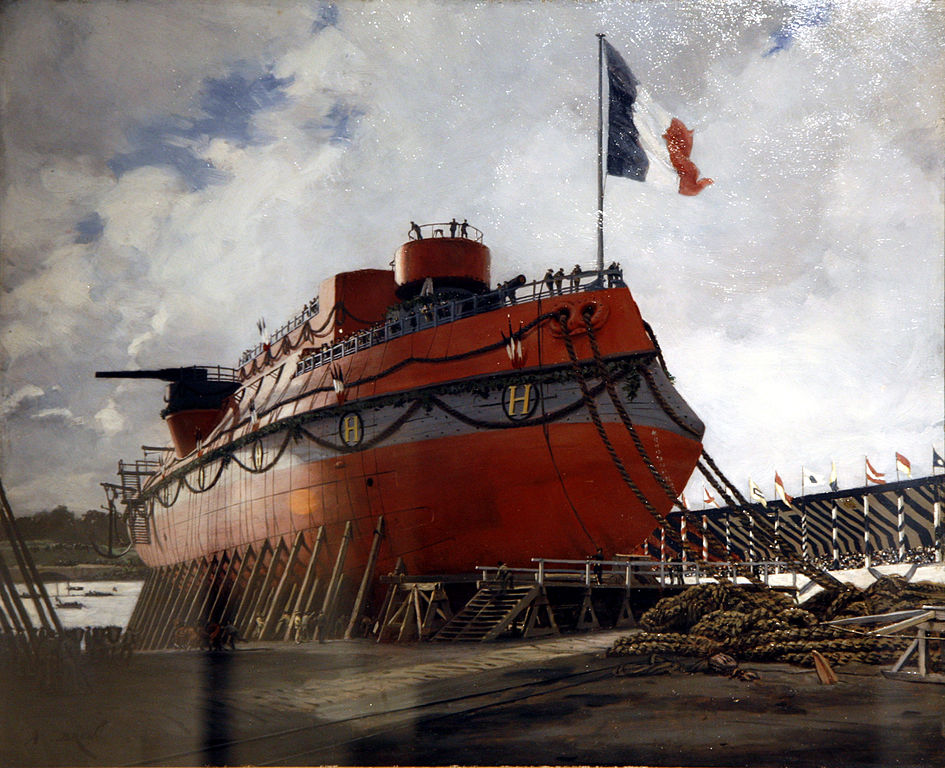
The controversial Hoche, before launch.
French battleships fought little during WWI. Their main theatre of operation was the Mediterranean, by agreement with the British. It was in effect devoid of any real naval threat. Before Italy entered war with the triple entente in May 1915, the Regia Marina was the only possible serious adversary for the French battlefleet, and once colors were announced, there was only one left: Austria Hungary and its small fleet trapped in Pola in the Adriatic. Nevertheless, the French fleet participated in the blocus of this sea, the control of Greece and the Aegean, and of course the Gallipoli campaign, loosing even more battleships than the British in this ill-fated endeavour, due to mines.
The Legacy of the 1880s and Young School
There was a long transition from masted ironclad to central battery ships like the Océan class in 1868, the Friedland (1873), Richelieu (1873), Colbert class (1875), Redoutable (1876), Courbet class (1882), and the 1879 Duperré, first barbette ship. But the first true, modern “steam-only” French battleships were the small Terrible class, still active in WW2. They perfectly represented the path chosen by the Young school, mostly geared towards a confrontation with the Royl Navy: Since the industrial output and financial wealth was completey different from Great Britain, the naval theoreticians thought the best course of action was some kind of asymmetric naval warfare at sea: Avoiding large scale battles with ships of the line (or modern battleships in that case) and tried to develop other avenues: Smaller, coastal battleships, armoured cruisers to prey on British shipping, and plenty of torpedo boats to re-establish the balance before the “decisive battle”.
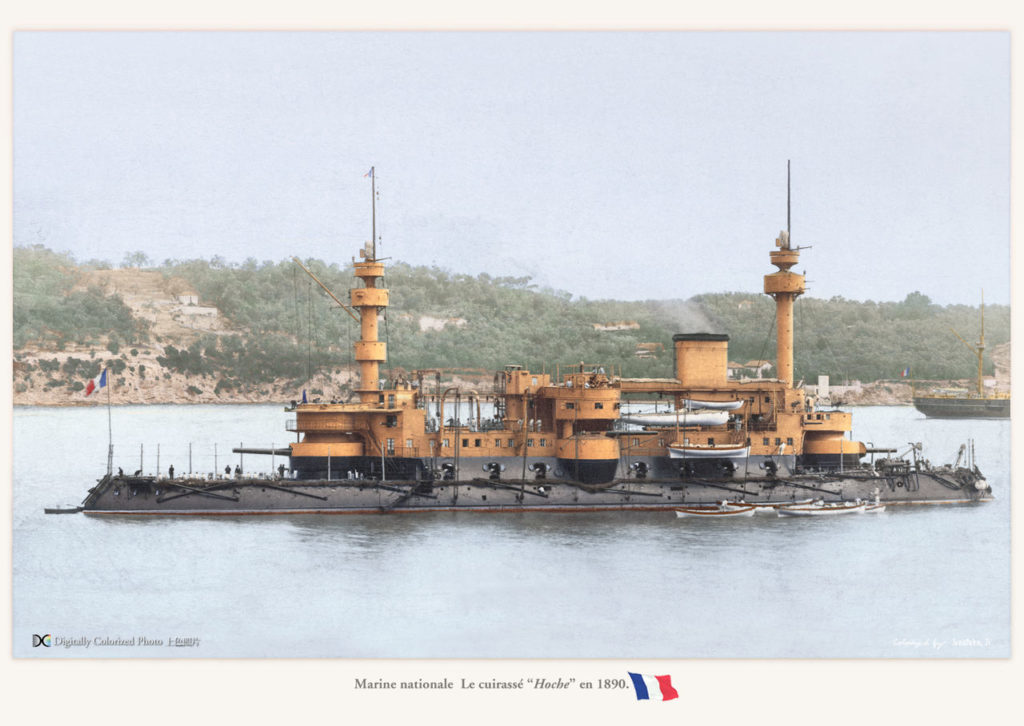
Hoche, colorized by irootoko Jr.
Armament of French Battleships
So despite this radical approach, battleships were still tolerated. But there was freedom left to experiment there. The end result, for the rest of the world was a complete mess. Instead of proceeding with incremental steps, and building large classes of very similar vessels which simplified training, maintenance and organization, and lowered the costs, the French took sometimes ten year or more to built costly, single battleships that incorporated many changes and ideas delaying their completion and making them all different, and obsolete, in the end. Calibers multiplied also, creating an ordnance nightmare: Devastation (1879) still existed in 1922, and had 340 (13.4 in) and 274 mm guns (10.8 in), the Terrible class had 19.3 inches and 3.9 in guns, the Baudin class 14.6 in, 6.5 in and 5.5 in, until the Navy settled on the 12-in caliber in 1893 with the Charles Martel. The French also made the choice of having longer caliber guns than in the RN to out-ranged them, but due to space issues, in single turrets. Due to the tumblehome, there was simply not enough space on the deck forward to accept a twin turret.
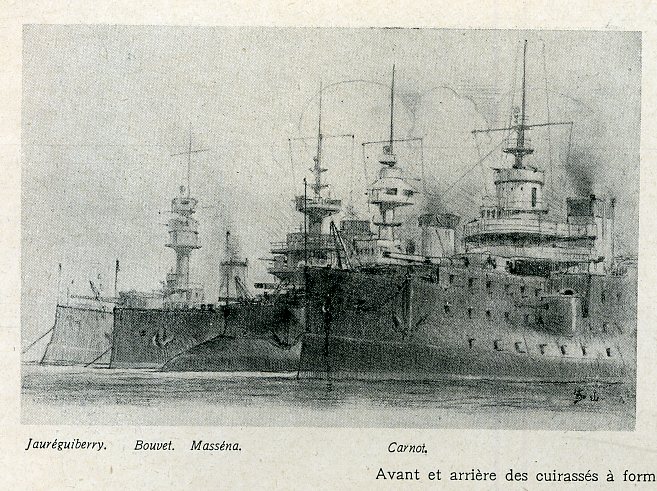
Jaureguiberry and other “Martel” class battleships
The Baudin had three main guns in the axis, one amidship, the Hoche, Marceau class, Brennus, and Martel “class” (Martel, Carnot, Jaureguiberry, Massena, Bouvet) repeated the same “lozenge” pattern, with the main guns fore and aft and two smaller side guns amidships, of 10.8 inches (274 mm), which range for the latter was thought to be equal to the British Vickers 12 inches. The peculiar place in side sponsons obliged engineers to place here lighter guns, but this solution offered three guns in chase and retreat, unlike countries that adopted the fore and aft twin turret/barbette approach. Only the French used this configuration, the only Country which adopted it was Spain, with the unique French-built Pelayo in the 1880s, an indication this was probably not the best approach to battleship design. It was recognised in France too, at last, when the Charlemagne class settled in 1895 on the fore and aft 12-in twin turret universal solution, getting rid of side sponsons for good. This pattern was repeated for the Iéna and Suffren, and the following République, Liberté and Danton classes, the latter going back to a massive secondary artillery, after the transition initiated with the Liberté class (8-in secondary guns). The French were however quick to use secondary turrets, deck level, instead of casemated guns: They started with the Brennus (1891), confirmed later until the Suffren (1899), which had a mix of both, with ten 6.4 in (162 mm), including eight in four twin turrets for and aft, the remainder four being casemated guns one level below, with large recesses in the hull. At the same time, the tumblehome and rams were made less prominent. This was the end of the young school, and a return to “normality” thanks to more sensible ministers of the Navy which saw the greater picture.
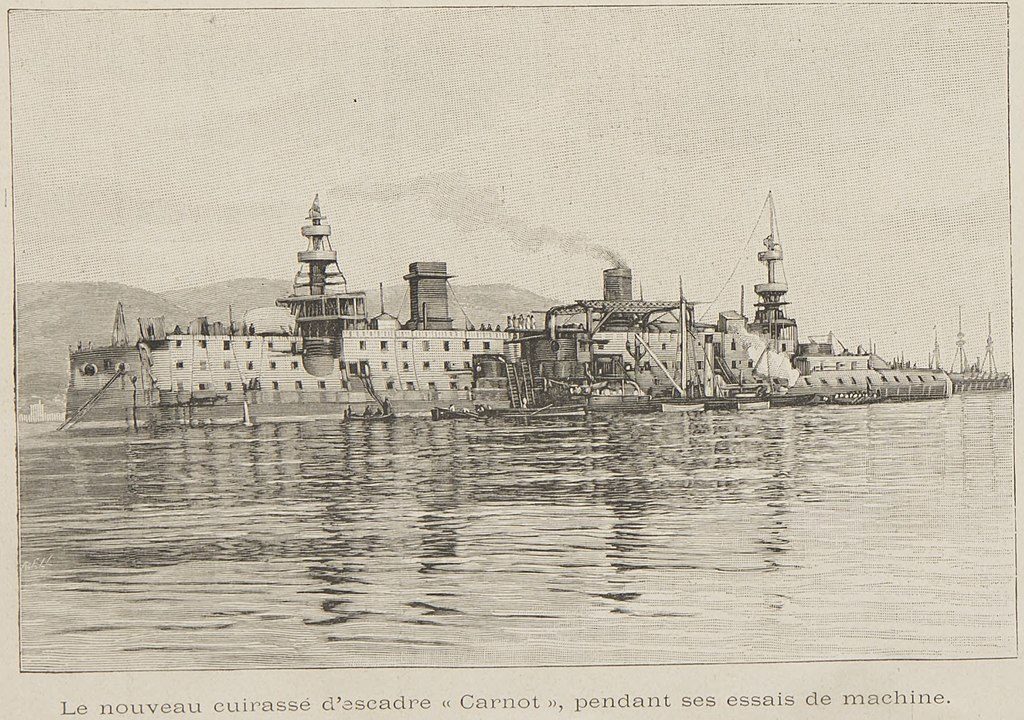
The Carnot, by Bougault in 1896 off North Africa
For secondary artillery, the French tried to be a step above the standards of the time (from Vickers) with 6.4 inches guns (162 mm) instead of the commonplace 6 inches (152 mm). It was an incremental step over the previous 5.5 in (138 mm), and improvement on the second standard of 5-in (127 mm). At last in 1904 and the Liberté class, the French introduced a heavy secondary caliber, at first, of 7.6 in (193 mm), below the standard 8 in and later also below the standard of 10 inches (254 mm) with 9.4 in or 240 mm adopted on some armoured cruisers of the time, and used on the Danton. It went back to 5.4 in (138 mm), also substandard, but compensated by range, on casemated guns on the Courbet, Bretagne class, Normandie and Lyon, and it was still largely used on destroyers until WW2.
For the light artillery, Hotchkiss, Schneider and St Chamond, prominent French arsenals and gun makers, provided the French Navy with quick-firing guns since the 1870s.
For torpedo tubes, submerged, often 4 to 6 were installed, of 450 mm (17.7 in) on later dreadnoughts and pre-dreadnoughts.
-Main guns (in service in WWI): 16.5 in, 14.6 in, 13.4 in (28, 42, 45 cal.), 12 in (40, 45 cal.), 10.8 in
-Secondary guns: 9.4 in, 7.6 in, 6.4 in, 5.5 in, 5.4 in, 3.9 in
-Tertiary/Anti-TB guns: 1-pdr revolver (37 mm), 3-pdr (47 mm) and 47 mm AA/40 mm AA on Lyon), 9 pdr (67 mm).
-Torpedo tubes: 14 in (340 mm), 17.7 in (450 mm), 18 inches (457 mm).
Protection
Protection-wise, Early French battleships from this era generally had a thick protection, often to the detriment of speed. For the old Devastation (1879) for example, the belt was 15 inches thick, whereas the caliber of the main artillery was 13.4 inches. This reported difference was even greater on the Duperré (22 in for 13.4 in), Terrible (20 in/16.5 in), Baudin (22 in/14.6 in), Hoche (18 in/13.4 in), Marceau, Brennus and following, the thinner armour being explained by the use of modern compound steel. It was made thinner on the Bouvet class, by using this time Harvey nickel armour (16 in/12 in) and finally Krupp Cemented armour from the modern République, Liberté and Danton classes (11 in/12 in).
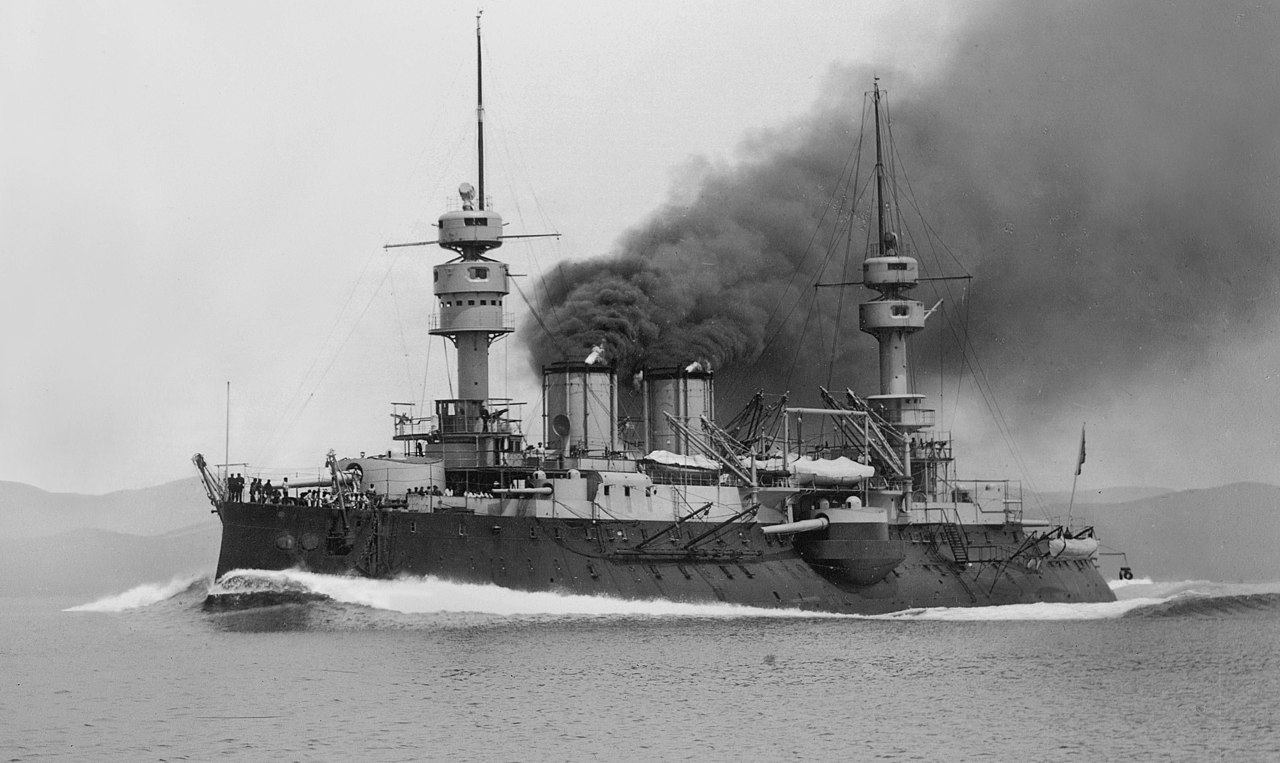
Jaureguiberry on sea trials – Marius Bar coll. The Navy and Army Illustrated, 1897, released in CC internationally since 1926.
Also they showed the tumblehome characteristic of their design, and a pronounced arm bow, more impressive than British ones. They had the tendency of making the bow “plough” in heavy weather, detrimental to stability, while the tumblehome idea, while in appearance a surveillance of the wooden ships of the line era for better stability, was a repeat of the same idea, allowing to push the superstructure higher, giving larger living spaces and raised platforms for light artillery. This went on to to the point of self-caricature, with the Hoche, the “Grand Hotel”, which height had to be lowered after entering service. The French advocated this pear shape made the ships more seaworthy, creating a greater freeboard and the concept was exported to the Russian Tsesarevich, but the Russo-Japanese War proved if the tumblehome design was good for long distance navigation, it can doom a ship quickly if the underwater integrity was lost, as it only aggravated the flooding problem. In fact three of the four with this design were lost, resulting in their abandonment.
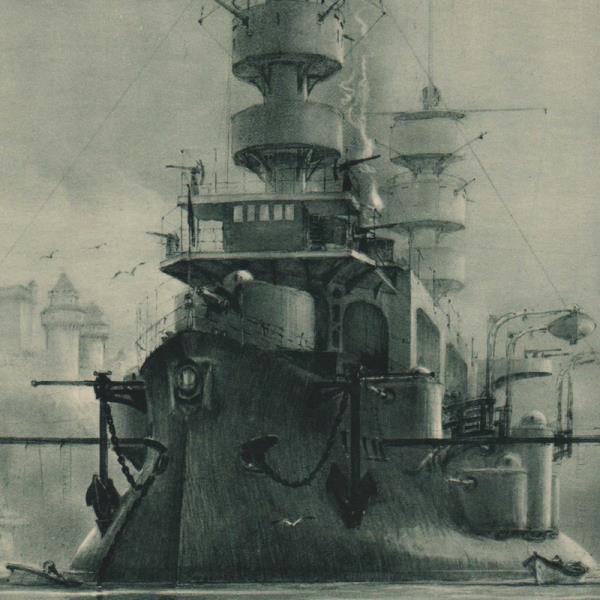
“Mastodonte”, a particularly impressive “castle like” engraving of the Martel, showing its tumblehome and thick military masts (and a castle in the background).
Another design trope of that area, typical of French battleship design and found nowhere else, was the use of heavy military masts. These structure, very much “tower-like” were indeed very large, as they supported a targeting platform and light artillery platforms, often on two levels. In some cases, these platforms were entirely enclosed, leaving only hatches embrasures opened for QF anti-torpedo guns. The idea of having them there was to maximize their arc of fire around the ship, and visibility to deal with approaching torpedo boats, but also, as it appeared, submarines, which were easier to detect when close underwater from a higher position. The mast was a lightly armoured tube with an internal ladder or staircase depending of the builder. On many battleships, they were built only foward, and from the République, it became a standard. They were completely abandoned with the Danton. Nevertheless, the Courbet, Bretagne and Normandie still had a thick, tubular mast forward, large enough of a ladder inside, but no longer gunnery platforms. Instead, Admiral Boué de Lapeyrière pushed for the adoption of light projectors. Located on top of these towers, once they disappeared, they were relocated around the aft mast as in other navies, or the bridge, and more of them were installed.
For armour scheme, it varied of course, from the barbettes ships of the late 1880s which had an integral belt running the whole length of the ship and connected to an armoured deck above waterline level, with thinner slopes and upper belt, heavily protected turrets or barbettes, tubes, but weak conning towers. For the “standard” Charles Martel for example, the CT was thicker at 9 inches, whereas turrets were protected by walls 15-in thick, all around, making them quite heavy. From 1900, the thicker part was always the turrets, not the belt, not the CT, which was still relatively weak. Only from Iéna, this became a thing, with for the first time a 12-in thick walled conning tower, and the belt thicker at 12.8 in than the turrets (11.5 in), which was inverted on the Suffren. The first modern pre-dreadnoughts classes of 1900 returned to well protected turrets, then CT, and finally belt, at 14-in, 12-in and 11-in respectively, and oblong turrets, still without slopes, but sides and rear tapered to 10 inches while the belt was no longer integral but tapered down to 3.2 inches on both ends.
On dreadnoughts, still no “all or nothing” scheme, but a weaker armour in order to regain speed and agility. This was the case of the Danton class, with a 10.2 inches tapered down to 6 in, 1.2-1.6 in for the two armored decks, 11-3/4 inches for the same cylindrical type turrets and a the same thickness for the CT. The Courbet were protected about the same, with 180 mm thick bulkheads, but the belt extended well below the waterline, as the French feared underwater hits.
Powerplants
We are going to concentrate on ships in active service during WWI here. Among the oldest battleships, the Marceau class barbettes ships vertical compound engines, with variable numbers of coal-burning boilers, 8 to 12, with Guyot Du Temple and Belleville becoming household names (the latter also used on Russian and Japanese cruisers and battleships). Engines were rather the specialty of each yard, Toulon, La Seyne, Brest, Lorient, Chantiers de la Loire*, were all involved in the final assembly but also the powerplant. The transition started with the Brennus, in a sense, first modern French battleship. Launched in 1891, she was given for the first time VTE engines (Vertical, Triple Expansion), coupled with no less than 32 Belleville boilers. The result was a 18 knots battleship (instead of 16 on the Marceau) which in addition had turrets for the secondary artillery. It was announcing a “relatively” homogenous group called the Charles Martel class (see above). All had two shafts. However, from the Masséna, for the first time, three shafts were installed, with compartmentation to avoid flooding of all the powerplant. This was in 1895, and submarines started to be respected as a potential weapon of war, in addition to be the golden age of torpedo boats.
From then on, this triple VTE engine became the norm, generally with Belleville boilers with an exception, the Henri IV and its Niclausse models. The latter were eventually found more efficient and started to replace completely the Belleville for all subsequent French Battleships: Suffren, the République class had Niclausse, as half the Liberté class, as well as the Danton class. The goal there was to provide enough boilers in a shorter time to fill the need of large classes. Five for the Liberté, Six for the Danton. The latter in that area also marked a turn: These semi-dreadnoughts were the First battleships in the French navy to be fitted with turbines, the first with four shafts, but still running on coal. Top speed reached 19.5 knots, versus 18 knots for all previous battleships.
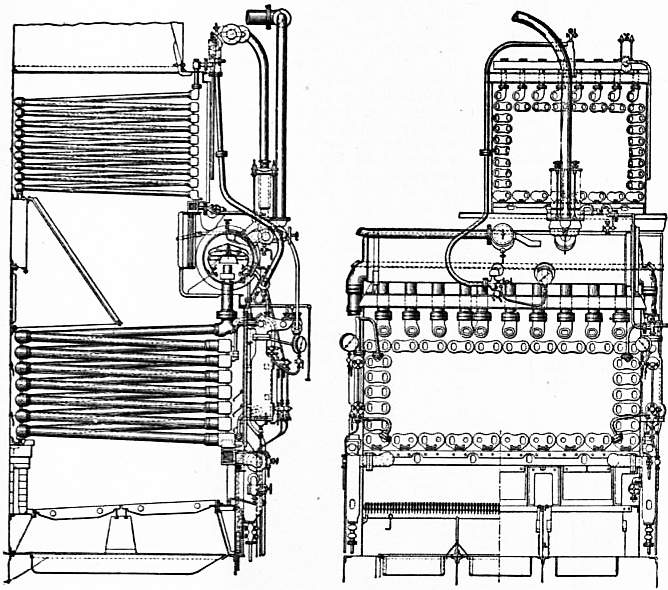
Belleville Boilers
The real game changers were of course the French dreadnoughts, the Courbet class which had a relatively similar arrangement but with 28,000 shp instead of 22,000 for 20 knots, and mixed coal/oil burn, notably oil sprinklers in coal boilers as it was a common practice at the time. The Bretagne had more modern and far larger Parsons turbines, only two, but driving four shafts, fed by either Niclausse, Belleville or Du temple mixed-burning boilers. The Bretagne were not fast, at 20 knots, whereas the contemporary Queen Elisabeth were capable of 24 knots. To give some perspective, the ratio carried was 900 to 2680 tons coal versus 300 tones oil. France traditionally had coal mines in the industrial north-east, but its growing colonial empire allowed some access to African oilfields already. The incomplete Normandie class mixed TE engines and turbines, and 22 knots were planned, whereas the superlative Lyon class were to be given also a mix of VTE (which consumed less) and turbines, for 43,000 shp and 23 knots.
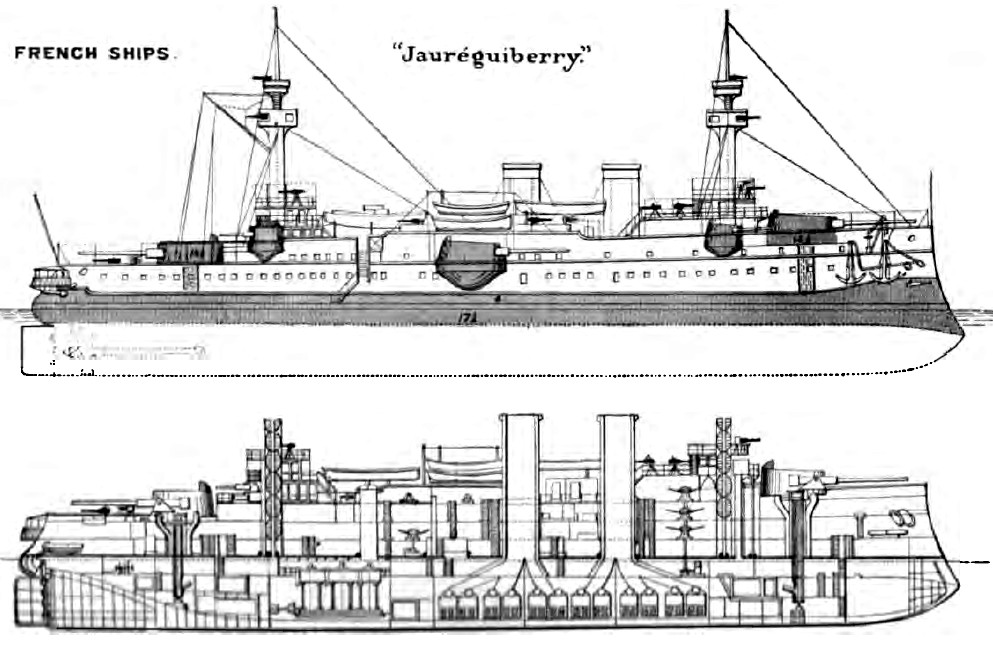

Battleship Jaureguiberry, internal arrangement (Brasseys naval register).
This picture would not be complete without mentioning the projected French battlecruisers of the Gilles and Durant-Viel types. The latter reached 26 knots on 4 shaft turbines and 18-21 boilers, still with a mix of coal and oil, but the Gille’s 1913 28,300 tonnes design was given 52 boilers for an amazing figure of 80,000 shp, allowing a top speed of 28 knots and more. Range was still 6300 nm at 15 knots. This was the same for the Normandie class, better than the Bretagne (4700 nm at 10 knots) or the Courbet (4200 nm), or Danton (3370 nm). The use of oil to fill ASW longitudinal compartments started in the interwar. To give comparisons, the HMS Dreadnought (1906) was capable of 6620 nm at 10 knots. However this lack of range was never seen as a problem, for the reduced dimensions of the Mediterranean.
French Pre-dreanoughts
The last barbette ships
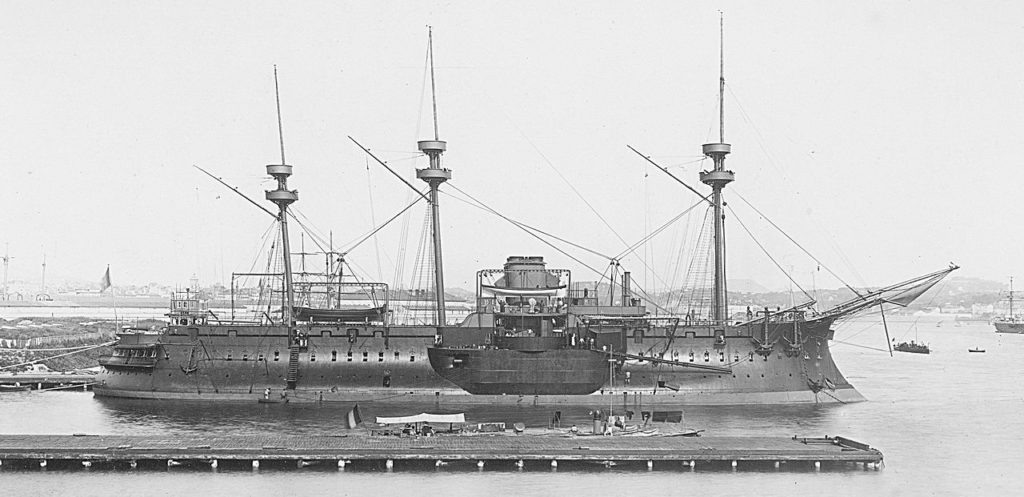
Predecessor to the Devastation class, the Le Redoutable was a massive ship using steel for the world’s first time in naval construction as primary building material, completed by iron.
Many French iron-built central battery ships from the 1870s were still afloat in 1900-1910 in various roles. The 1879 Courbet, Devastation and Duperré (for the latter, first barbette ship), looked like three-masted battleships but their rigging was reduced, but they carried four relatively heavy (13.4 in /340 mm), short barrel (18-21 cal.) guns. The all-steel built Devastation was also the largest warship of her time, in 1882. But the first true “steam only” French battleships were the odd Terrible class, typical of the young school theories.
They were almost half the displacement of the previous Duperré, but had the two most massive guns ever fitted on the French battleship: 16.5 in guns (420 mm) on 19.3 or 22 caliber. They were kind of coastal battleships, with their low freeboard. Contrary to the others, they were rebuilt, modernized and participated in WWI (see later).
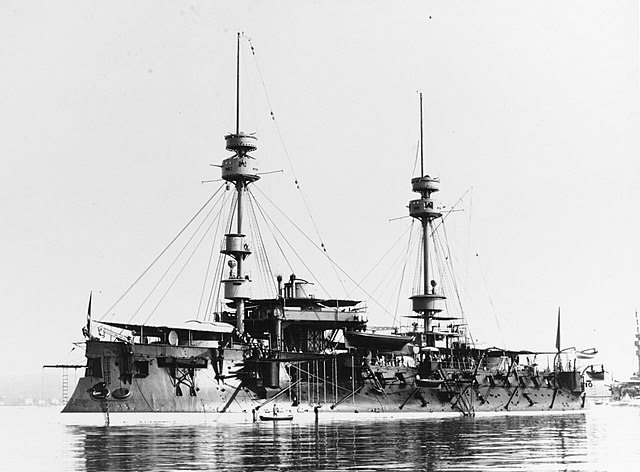
The Admiral Baudin class (Baudin, Formidable) were closer in concept to the Duperré, with three guns in the axis. Also, both were barbettes battleships, discarded in 1909-11. The last in this serie was the Hoche, another experimental vessels using a low freeboard, pronounced tumblehome, lozenge artillery, innovative turret-barbettes. Ridiculed as the “grand hotel” it encapsulated all that was wrong with the young school, including a construction over nine years and many modifications during service. She was unceremoniously sunk as target on 25/11/1913.
The Marceau class, last barbette ironclads
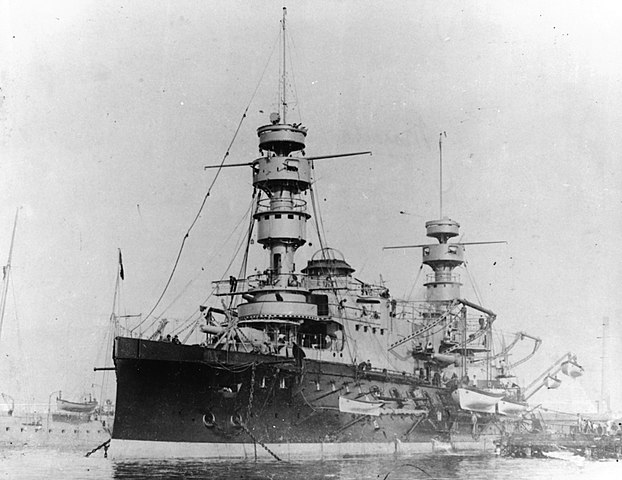
French Ironclad Magenta, the last completed of the Marceau class, last barbette ships in the French Navy.
These were actually the oldest “battleships” in service with the French Navy before 1914. Not only they had been laid down in 1881-83 as barbette ironclads, but they differed between them, and were still active before WW1, modernized. They were given new water-tube boilers in the early 1900s and their top-heavy superstructures and military masts were cut down. They saw limited use, Marceau and Magenta as training ship from 1903, whereas Neptune was mothballed. The parliamentary in 1908 decline any modernization of her as a waste of funds and she was struck from the naval register, in 1909 or possibly as late as 1913. Magenta was struck in 1910, but Marceau was converted as a floating workshop, supporting torpedo boats and submarines from August 1914 until the end of the war. Sold to ship breakers in 1921, she ran aground in a storm off north Africa and her wreck was left there to rot, still visible in the late 1930s. It was not known if this conversion included the removal of her artillery, and in that case she would have been potentially reactivated as a coast defence ship if needs be. She operated in Malta at first, but later moved to Corfu and then Bizerte in 1918.
The rebuilt Requin
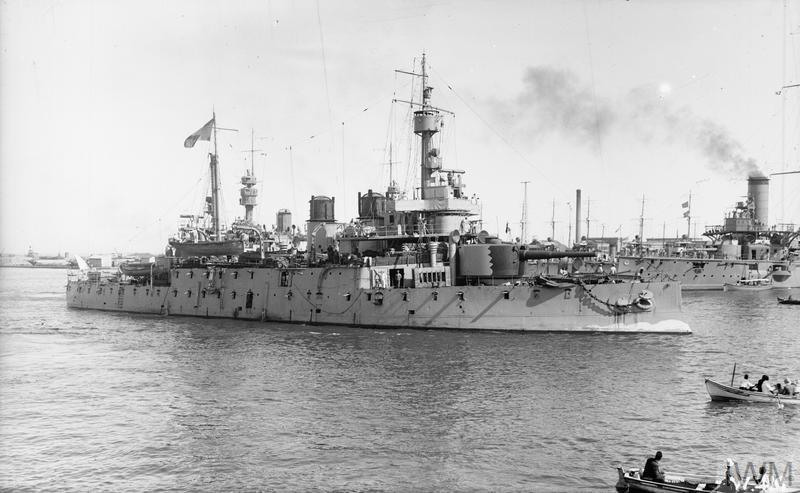
Requin in the Suez canal – notice the camouflaged forward turret. photo IWM.
These even older barbette ships, laid down in 1877-78 and completed in 1887-88 had a quite formidable artillery in the 1900s when they approached the end of their career. Terrible was discarded in 1911, but Caiman, Indomptable and Requin were modernized. In 1898 already, these ships received much lighter 10.8 inch guns instead and the lighter artillery was changed to QF M1893 3.9 inches guns, TTs removed or reduced on all. But later Requin was taken in hands for further modernization. Her engine room was refitted with 12 Niclausse boilers coupled with two new VTE engines and new centerline funnels as a result. Quite different than the others, with single turrets for and aft, she served as a guardship in the Suez canal during the war. She was stationed in Ismailia in December 1914, as the entente feared Ottoman attacks from the northeast. In January 1915, Requin advanced further north to support of foray of British and French cruisers along the coast and later she joined the patrol. A berth was dredged in the delta, at Lake Timsah for Requin, now able to support ground forces at the northern end of the canal. She later teamed with D’Entrecasteaux early February 1915, Requin being heavily engaged by Ottoman field artillery batteries. Her main artillery quickly settled the matter and the Ottoman attack broke down. This was her most serious test in her guard duties. All three were discarded after, Requin in 1920 and the others in 1927.
Brennus (1891)
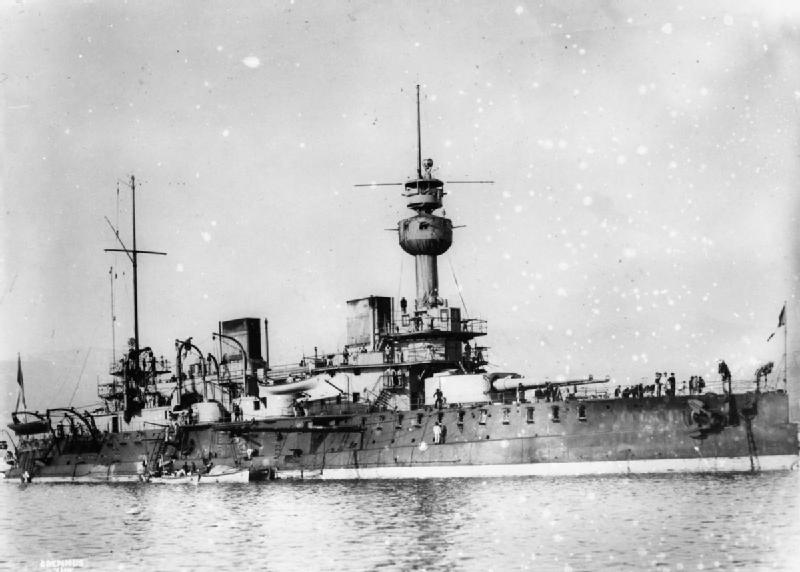
The Battleship Brennus – Symonds and Co Collection (cc)
Named after a Gallic chieftain leading the invasion of the Balkans in 280 BC (in fact that was a generic term, not a name, like Vercingetorix), Brennus marked a step in size and features. She presented several innovations, but was criticized as well, not least because of its armament. Instead of the four 13.4 in of the Hoche Marceau class, it had only three. One in the aft turret and two in the forward turret. However they were of 42 caliber M1887, versus 28 for the former M1881. This greatly improved range and muzzle velocity, therefore penetrating power. Started in Lorient in 1889 in the same basin used previously by the Hoche, she was almost 1,000 tons heavier, and much longer at 110.29 m. She was the first battleship not to use the lozenge configuration but concentrating the armament in axial turrets. She also was the first with single turrets for secondary guns and casemates. She was also roomier and carried way more boilers, of the modern Belleville type, giving a total output of 14,000 ihp versus 10,000-11,000, resulting in a top speed in excess of 17.5 knots (more than 18 knots on sea trials).
However all this rosy picture was destroyed by poor calculations; As first she was 15 feets over designed draught, and this was without fuel, supplies and ammunitions. She lacked seriously in initial stability. This was such that the ship, launched in 1891 was only completed in 1896, so after five years, and in addition had to be curtailed after her first trials. The military mast aft was completely removed as well as most of the initial superstructure, but even with this, she was still overweight, her belt dangerously deep below water. The protection called for steel and compound. latter was complete, 7ft 3in wide, at the lower edge but 2 ft above water. Amidship (citadel), this was 18 in tapered down to 12 in whe connected to the armoured deck and 10 in lower edge. The latter deck was double, with a layer of 2 in and one of 2.4 in, assembled with twin 0.4 in plates. Also unusual in her design, Brennus had no ram. Her Belleville boilers were a true innovation, although at that time without economisers (first gen). Her artillery was remarkable for the time, but she was completely spoiled by an inadequate displacement and narrow beam. She was in reserve already in 1914 and was scrapped in 1922. In between her above water torpedo tubes and 1-pdr quick firing guns from Hotchkiss were removed to made the ship a tad lighter.
Specs:
Dimensions: 11,190 tons, 110.29 x 20.4 x 8.28 m
Power: 2 shafts VTE 32 boilers, 13,900 ihp 17.5 kts coal 600/980 tons
Armour: See notes. Upper belt, battery, casemates 4 in, turrets 18 in, CT 6 in
Armament: 3x 13.4 in (340.3 mm), 10 x 6.4 in (162.5), 4x 9-pdr, 14x 3pdr, 6x 1pdr*, 4x 18in TTs aw*
Charles Martel class, and the “standards” (1893)
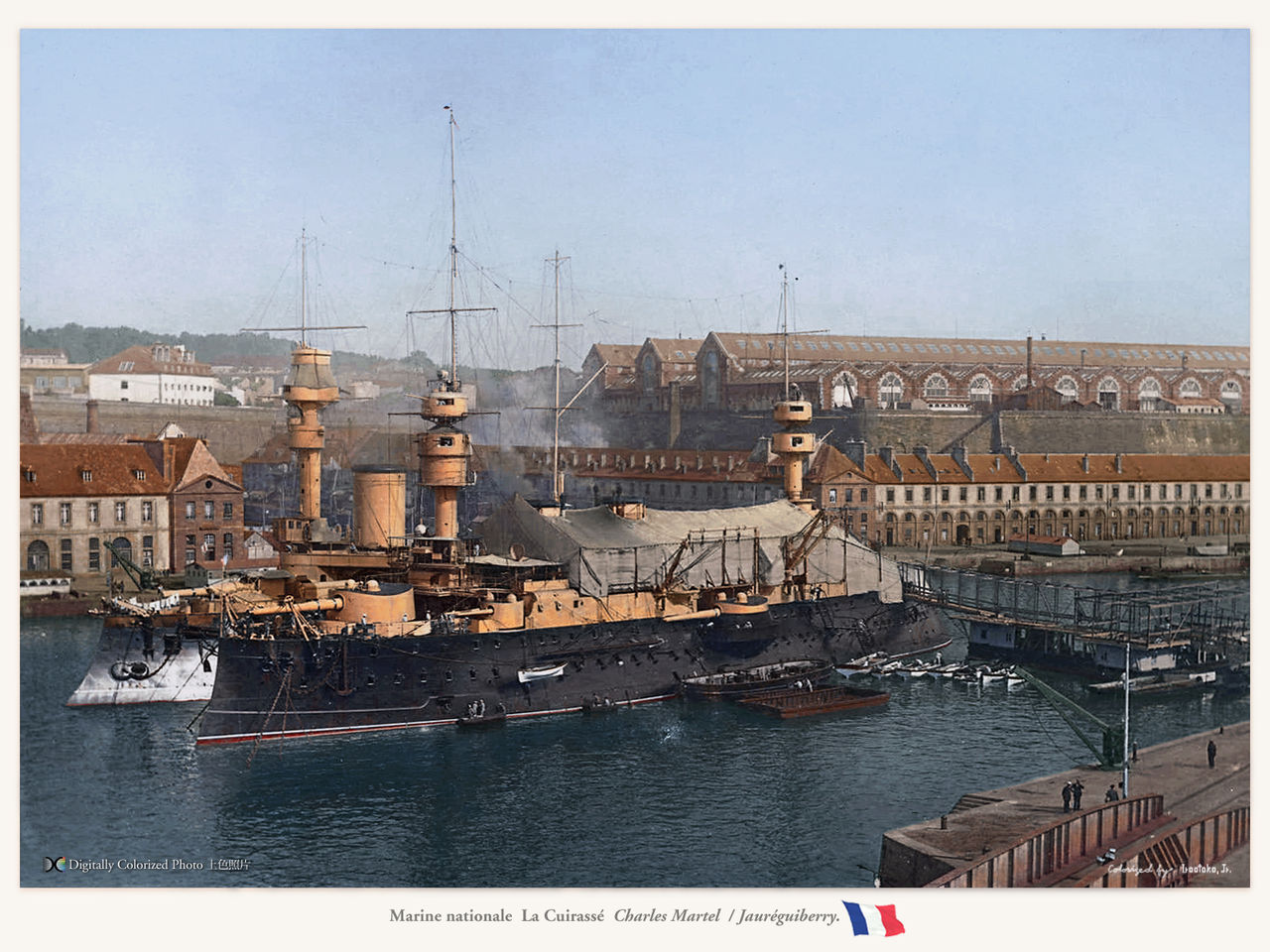
Charles Martel & Jaureguiberry, credits irootoko jr.
This was a class “per se” although composed of varied ships, as all answered the same specs and were rather similar in many aspects, by facility from authors and historians. Nevertheless, on conway’s they are all separated. A dispersion that recalled somewhat the Russian Imperial Navy of that time (which was influenced by French design and the young school as well). None was active during the war but the last two, blooded at the Dardanelles. In common also they returned to the bad habit of mixing heavy and semi-heavy guns in typical lozenge formation, and their powerplant was largely inspired from the Brennus. Construction started in parralel: Charles Martel at Brest in april 1891, Carnot at Toulon in July, Jaureguiberry at La Seyne (Toulon) in November, Masséna in Chantiers de la Loire in September 1892, Bouvet in Lorient in January 1893. Armament was weak compared to the standards of the time, but the young school was so confident in this design, it was maintained for all four others, started in 1891 for three, 1892 for the next and 1893 for the last. They were completed in 1897-98 and already obsolete.
Charles Martel (1893)
Charles Martel, Jauréguiberry, Carnot, Masséna, Bouvet
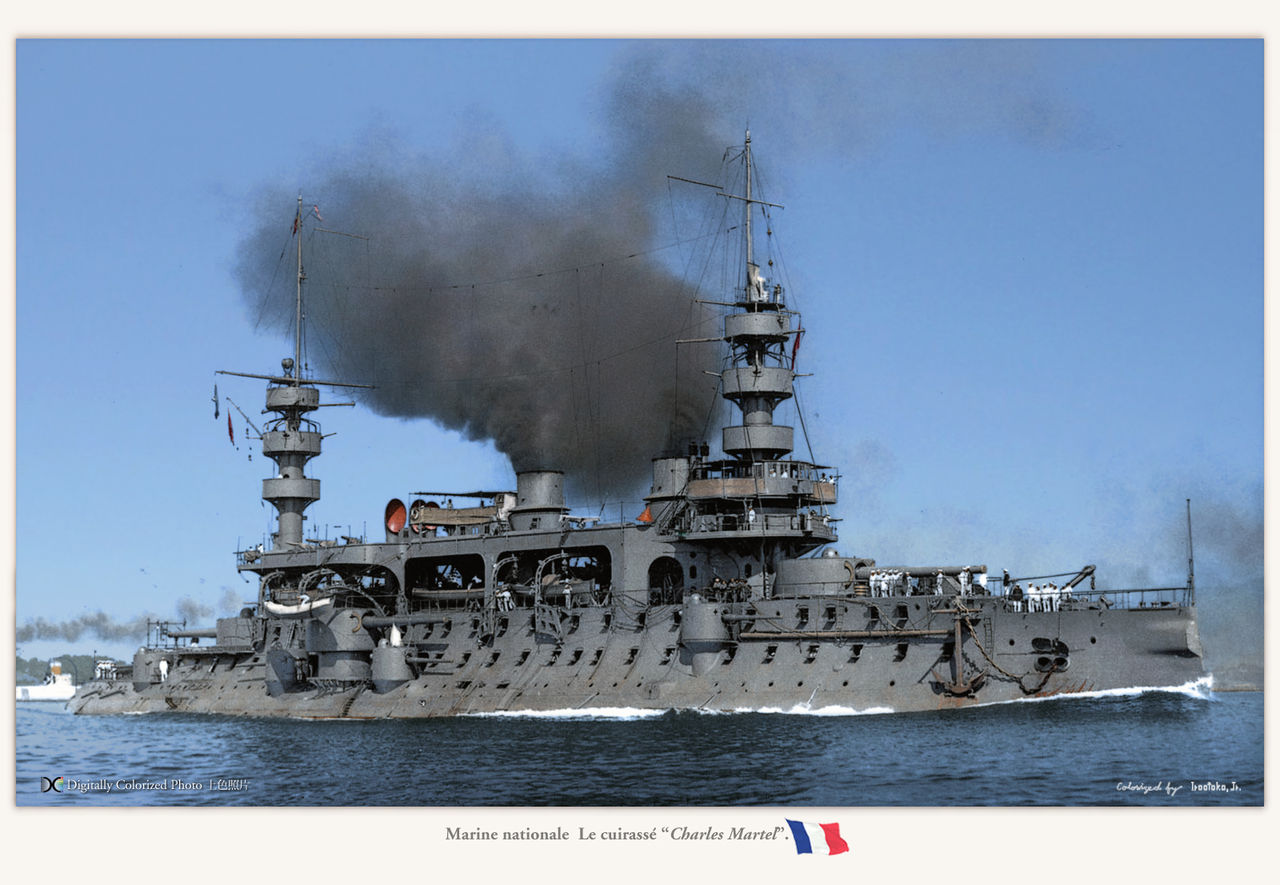
Abusively described as single class, but broadly similar, this “standard” started with Charles Martel. She had a forecastle for a higher freeboard forward compared to the stern compared to the flush-deck Brennus. She had typical flying deck between the military masts and experienced stability problems. Some superstructures were later deleted as well as her aft military mast to regain some velocity. Contrary to Brennus she had a ram, was heavier, longer and larger, but instead of using twin turrets, in part because of the tumbelhome, she had a single turret forward and aft with less heavy guns than the previous ships: Two 12-in and two 10-in on the broadside, their barbettes exposed along the pear-shaped sides.
There was a complete armour belt 7 feets 7 inches in height, of which 1 feet 8 inches was above water. The central section amidship reached 18 inches (upper edge) tapering to 12 inches down to 10 in forward and aft. The upper belt was complete and 4 feets wide, up to 10 forward, 6ft aft. The armoured deck was somewhat arched from the main belt upper deck and sloped down at the bow. It was a 2.7 in sandwich with twin 0.4 in plates. The second armoured deck was 2ft 8 inches below and 1 inch thick. It was formed by a continuation of the inner bottom, and space divided into many small compartments like the space amidships on the armour decks. These outwards compartments could be filled with coalor stores. A rather good idea, it was called the “tranche cellulaire”, a cellular layer in favor for french designers at that time, which indeed improved ASW protection. Secondary 5.5 inches were in single turrets either side of the main broadside barbettes. Engineers gave the metacentric height of 4 feets, but on trials she was plagued by the same defects as Brennus -though at a less critical level- and was lightened up during service. In the reserve division with Brennus, Carnot, and Hoche in 1902, in the 3e Escadre de ligne on 5 October 1910 based in Brest, full reserve in 1912, and like Brennus, Carnot and Masséna, she was decommissioned and hulked to serve as a barracks ship in April 1914, and later deprived of her guns during the war. She was scrapped in 1922.
Specs:
Dimensions: 11,693 tons, 115.5 x 21.64 x 8.38 m
Power: 2 shafts VTE 24 Lagrafel boilers, 14,900 ihp 18 kts, coal 650/980 tons
Armour: See notes. Upper belt, battery, casemates 4 in, turrets 15 in, CT 9 in
Armament: 2x 12in/45 in, 2x 10.8in/45, 8x 5.5 in, 4x 9-pdr, 16x 3pdr, 8x 1pdr, 2x 18in TTs aw*
Crew: 644-667
Jaureguiberry (1893)
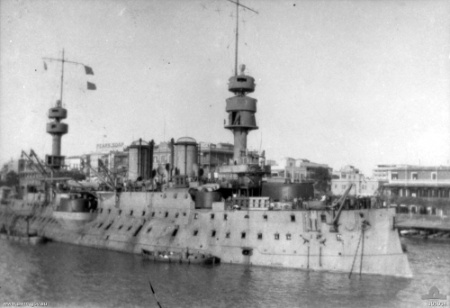
Essentially similar but with a shorter hull, wider beam and her main guns closer to the ends of the hull fore and aft. She was less powerful and slightly slower. She presented two large military masts but no flying bridges, two close funnels of equal size, and her 5.5 in were in twin turrets fore and aft abreast their forward and aft superstructure. She also had six boilers rooms instead of four. She only served in the early part of the war: She was part in August 1914 of the Division de complément, and sent to French North Africa and patrolled the area with Bouvet, Suffren, and Gaulois, under command of admiral Boué de Lapeyrière, the French jackie Fisher; She was in the Syrian Division, and fought at the Dardanelles, became flagship of admiral Guépratte. She covered the Landing at Cape Helles and participated and Second Battle of Krithia on 6 May 1915. She also bombarded Haifa on 13 August, covered the occupation Rouad is. in September. Refitted at Malta in 1916 she was posted at Port Said until the end of the war and partially camouflaged. Sent to the reserve in 1918 she was BU in 1934.
Specs:
Dimensions: 11,637 tons, 108.51 x 22.15 x 8.43 m
Power: same but 14,400 ihp 17 kts, coal 680/980 tons
Carnot (1894)
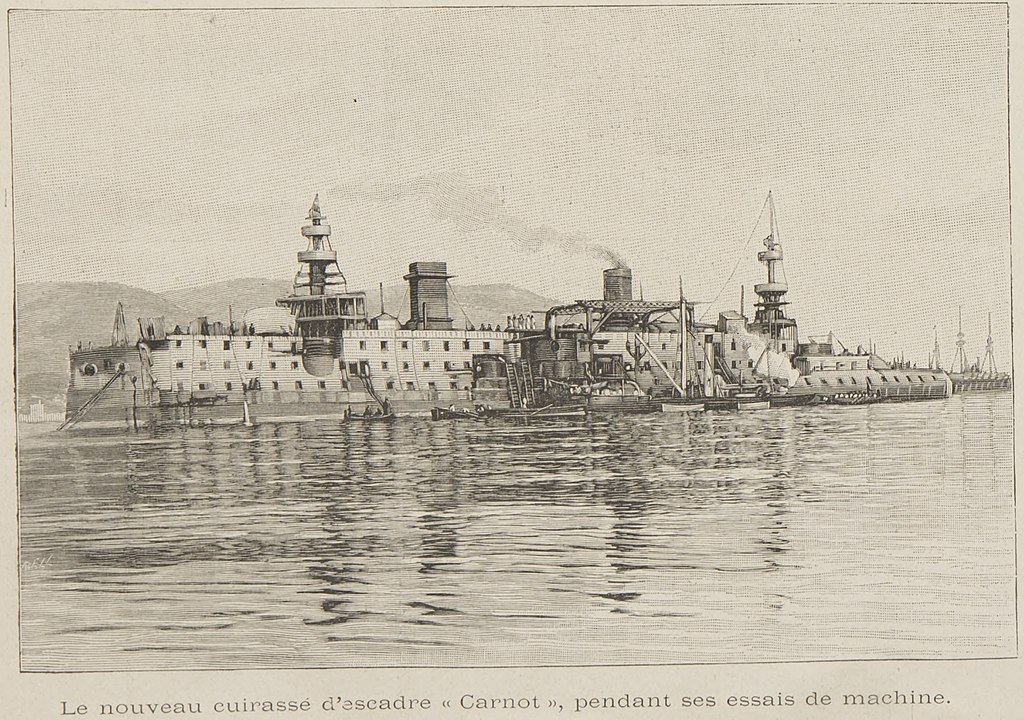
Battleship Carnot – illustration, Coll. Bougault (cc)
She differed by her hull form, higher forward freeboard, no flying deck, ad a single forward military mast. She also had two well spaced funnels of different diameter. She was placed in the reserve in 1914 with Charles Martel in Brest, Britanny (NW France), pending replacement by one of the new Normandie class dreadnoughts in construction. She was stricken in 1922 and BU.
Specs:
Dimensions: 11,954 tons, 114 x 21.4 x 8.36 m
Power: 2 shafts VTE 24 Lagrafel boilers, 13,300 ihp 17.8 kts, coal 680/980 tons
Masséna (1895)
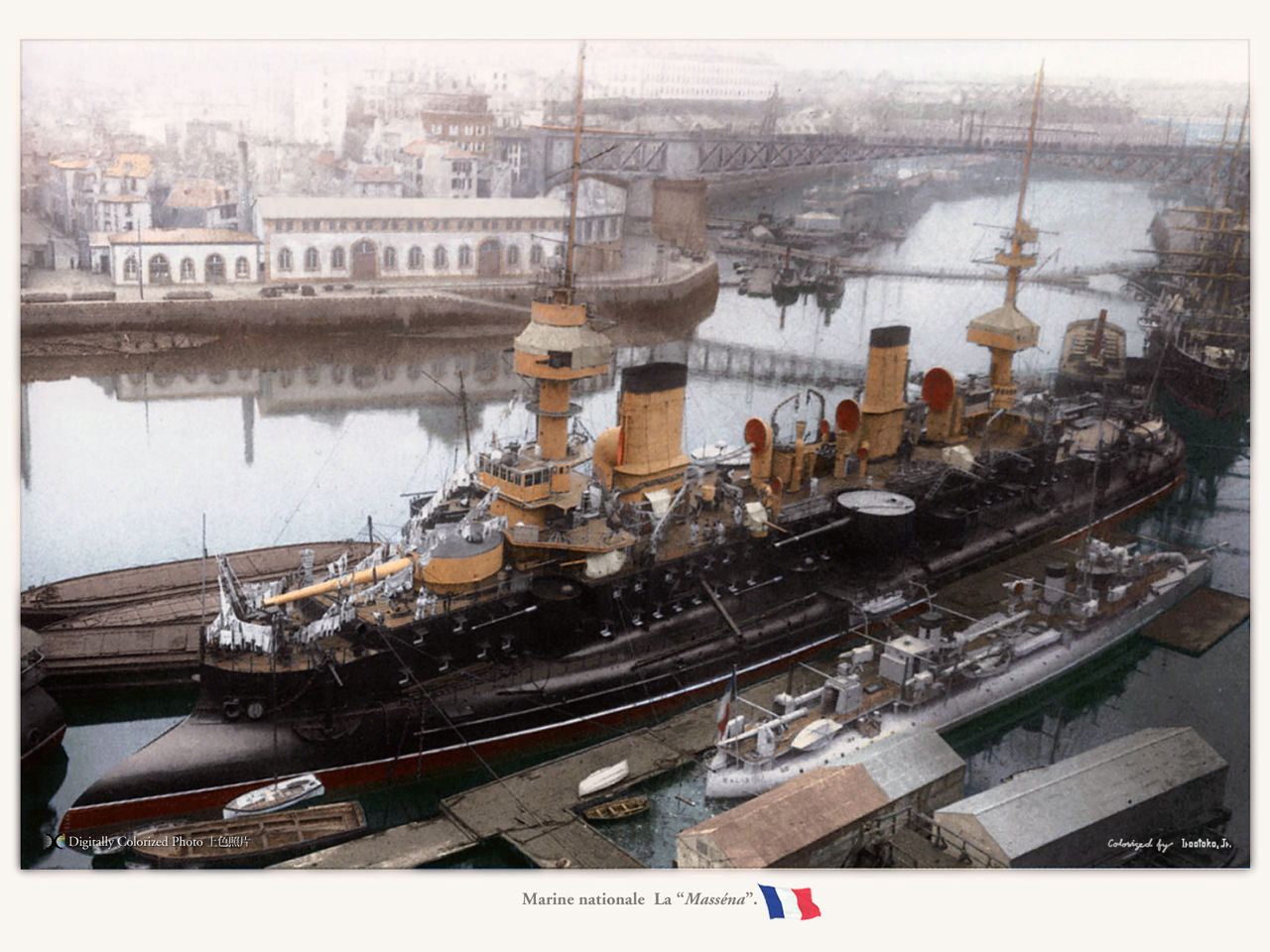
Battleship Masséna- irootoko jr
Not a very successful battleship built in Chantiers de la Loire (Nantes, south Britanny), she displaced 10,830 tonnes standard as designed but revealed 1,000 tonnes overweight, making her actual belt lower in the water than it really was. She was slightly more powerful with her 24 Lagrafel d’Allest and had three shafts instead of two but was slow and unstable. Her superstructure was later cut down as her aft military mast to regain some buoyancy. She also had a pronounced snout bow and far apart funnels, short military masts. She had tendencies of ploughing heavily in heavy weather, even reported as “unduly immersed” in British reports. She had armoured deck more far apart than in Martel, and still the cellular layer. Her wartime career was not impressive, even before the war broke up Naval Minister Ernest Monis decided to discard her. She was a hulk in 1915 in Toulon. Ultimately her only utility was to be towed to Cape Helles on the Gallipoli peninsula in November, and scuttled there to form a breakwater. This secured the evacuation effort of the Allied expeditionary force in January 1916. She was scrapped after the war.
Specs:
Dimensions: 11,735 tons, 112.65 x 20.27 x 8.84 m
Power: 3 shafts VTE, 24 D’Allest boilers, 14,200 ihp 17 kts coal 620/980 tons
Armour: See notes. Upper belt, sec.turrets casemates 4 in, turrets, CT 14 in
Bouvet (1895)
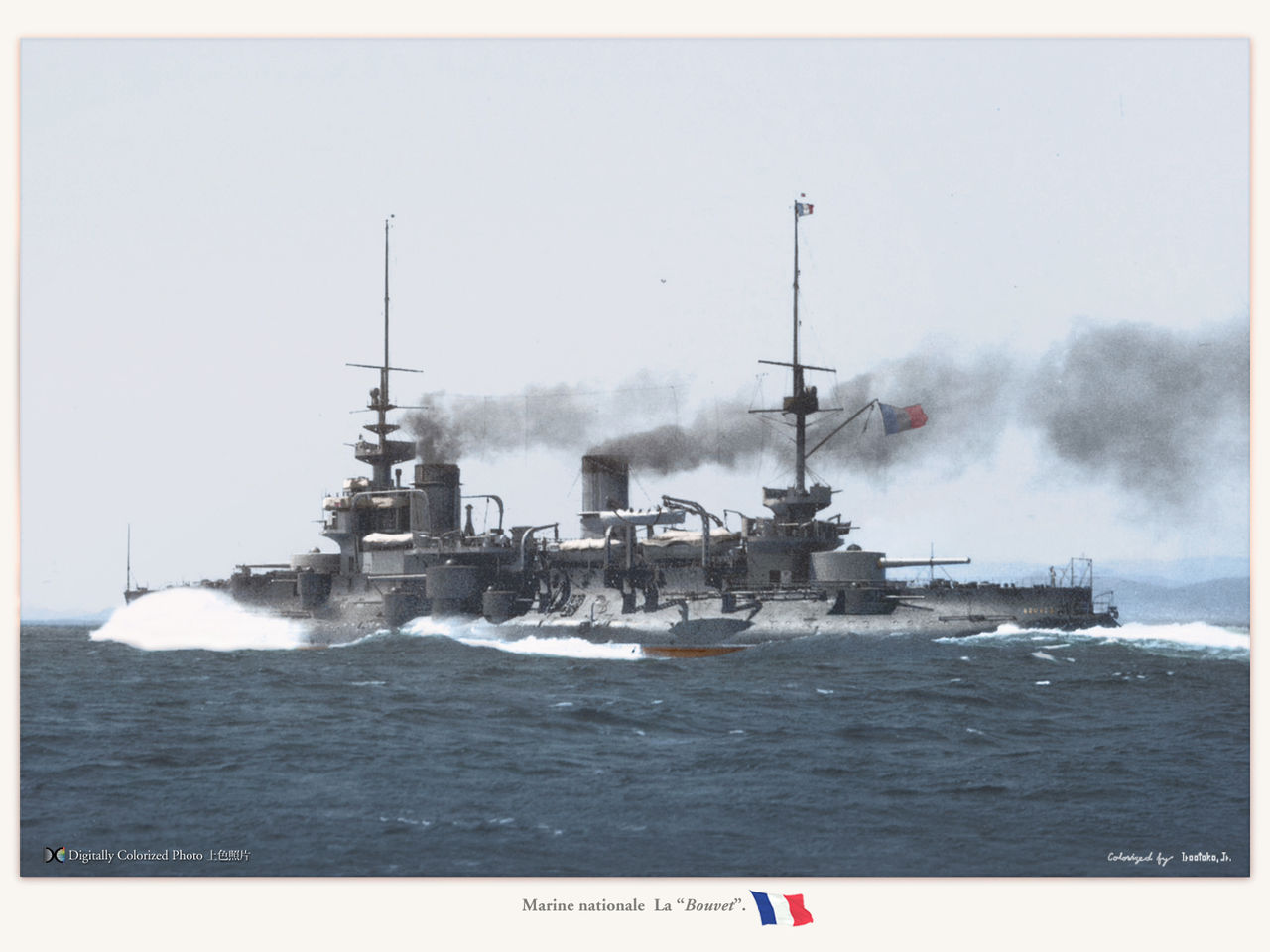
The Battleship Bouvet- irootoko jr
In the wake of battleships of the Charles Martel type, Bouvet was the last of this serie. She was started as “Orient” in 1893, and delivered in 1898. Her hull was different, with a raised aft hull, but still a tumblehome. Her superstructures were a little lower and stronger at the origin so she did not suffered much from being overweight or unstable. She had two full-length armored belts. Overall, her protection was by far the best of the five. She proved it at the Dardanelles, taking many hits without suffering much. She faced indeed Turkish forts in March 1915 and carried out her task quickly but was eventually eight times below the waterline, still without sinking. Her ondoing was hitting a mine previously laid by the Nusret. The explosion of its bunker was likely due to the failure of her cordite gas extraction system. This broke her back and she sank and capsized in less than two minutes, taking most of her crew with her, less two survivors. This was one of the major losses of the entente in Gallipoli and a reason why battleships were retired from the area, focus shifting now on land operations.
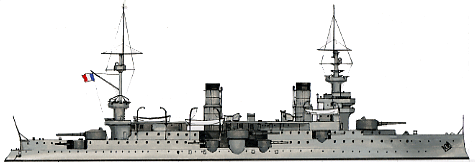
Specs:
Dimensions: 12,000 tons, 117.81 x 21.39 x 8.38 m
Power: 3 shafts VTE 32 Belleville boilers, 15,000 ihp 18 kts coal 610/980 tons
Armour: See notes. Belt 8-16 in, Upper belt, battery, 4 in, casemates 4.7 in, turrets 15 in, CT 12 in
Armament: Same but 8 x 5.5 in, 8x 3.9 in, 12x 3pdr, 7x 1pdr, 4x 18in TTs aw*
Charlemagne class (1895)
Charlemagne, St Louis, Gaulois
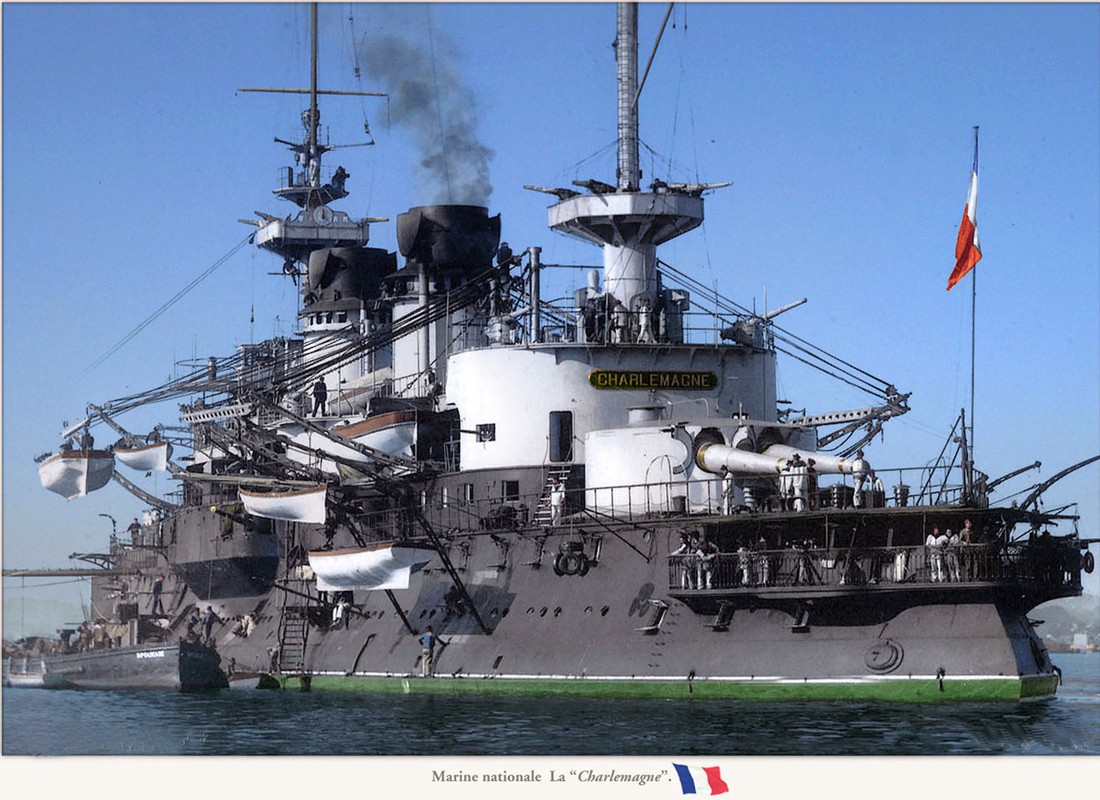
Charlemagne, credits irootoko jr.
The Charlemagne class was a true game changer. First off, these were the first French battleships to be built in a single homogenous class, and the first also to bear two tin turrets with 12-inches guns, the standard of the time for pre-dreadnoughts. However agai, calculation mismanagement led to be overweight, lowering considerably their belt armor and making them vulnerable above the waterline. The complete belt comprised an amidship section 14.5 inches tapering to 8 inches at tle lower end for the central upper section and 12-in down to 10 inches at the ends. It was conneted to the main deck forward but 3 feet 4 inches elsewhere. There was a cofferdam and cellular layer as previous design. The hull still had the characteristic tumblehome, but les pronounced.
Not flush deck ships, not single level gap with the forward section, it was elevated for half that heiht. In addition the forward main turret was elevated on an armoured barbette, but these were mounted on pivots like previous turrets. Secondary armament was all in casemates, including four in sponsons. They had two military masts and mixed above and underwater torpedo tubes, all removed during a refit. The 3.9 in were in the superstructures and lighter guns in the military masts tops. All three were started on each fiscal year, Charlemagne at Brest in 1894, St Louis in lorient, 1895 and Gaulois in place of Charlemagne in 1896. Lauched 1895-96, completed 1899-1900 (St Louis). They were the spearhead of the French Mediterranean squadron during WW1 and fought at the dardeanelles, where Gaulois took a hit on 18.3.1915 close to the port bow underwater, tearing the hull plating and the ship was quickly flooded by faultly ventilation trunks. She did not sank thanks to her crew action, but was later sank on 27.12.1916 by UB-47, 80 miles off Milo. She stayed afloat for 25 minutes, allowing to save almost all the crew. Charlemagne was stricken in 1920 and St Louis hulked, surviving until 1933.

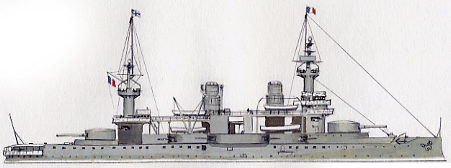
Specs:
Dimensions: 11,100 tons, 114 x 20.24 x 8.38 m
Power: 3 shafts VTE, 20 Belleville boilers, 15,000 ihp, 18 kts, coal 1080 tons
Armour: Main belt 14.5 in. Upper belt, battery, casemates 4 in, turrets 15 in, CT 13 in
Armament: 4x 12 in M1893, 10 x 5.5 in M1893, 8x 3.9 in, 20x 3pdr, 4x 1pdr*, 4x 18in TTs*
Henri IV (1899)
Henri IV was one of the most unusual French battleship of the time and perhaps one of the best delusions of the “young school”. She was basically developed as a very large coastal battleship, using notably a very low freeboard as protection. Therefire she had a unusual three staged forecastle, with a surelevated main foward turret, surelevated aft main turret, superfiring secondary one, whereas the other 5.5 in were in casemates. Only one forward military mast, and very low freeboard aft deck. This remarkably odd warhip was an experiement and was not to be integrated in a battleline as a main armaent of just two 10 inches was really weak. Her armour in Harvey nickel was also adjusted on this caliber and weaker than battleships of the time. Built at Charbourg between 1897 and 1903, she saw active service at Gallipoli and was stricken in 1921. For more, click on the title to access the main article.
Specs:
Dimensions: 8,800 tons, 108 x 22.20 x 6.98 m
Power: 3 shafts VTE, 12 Nicausse boilers, 11,000 ihp, 17 kts, coal 725/1080 tons
Armour: Main belt 3-11 in, upper belt, battery, casemates 4 in, turrets 12 in, CT 9.5 in
Armament: 2x 10 in M1893, 7 x 5.5 in M1893, 12x 3pdr, 2x 1pdr, 2x 18in TTs
Iéna (1898)
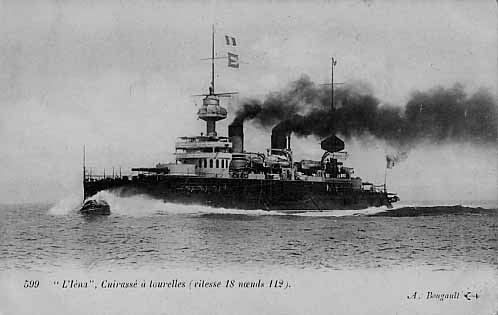
Iena, Bougault Coll.
Basically an enlarged Charlemagne, with a displacement reaching 11.860 tonnes and an overall lenght of 122 m. Iéna had the customary full lenght armoured belt, extending 3 feets above water, 4 feets below, on 275 feets she was 12.8 in thick, and gradually reduced to 9 in at both ends. It was tapered down at tle lower edge to 4.7 in. She had an upper belt in two strakes of 4.7 and 3.2 in for a combined 6 in. It was increased at the bow but lowered at the stern. They had also the usual cellular layer, main armour deck 2.5 in thick, or hardened steel 0.7 in and lower deck of 1.3 in. As the previous class, two tin turrets fore and aft, same 40 caliber 305 mm battery modele 1893-96. The secondary battery however came back to eight 162 mm casemated guns, including two in sponsons amidships. Lighter guns were in the superstructure or the two armoured masts fore and aft. Lower superstrcture and better calculation spared surprised with this design. Iéna had bilge keels but despite of this, rolled and pitched excessively in bad weather. Built in Brest 1898-1902 she was blew up by an accidental explosion in 1907. It was likelt due to the decomposition of nitrocelulose propellant in the after 3.9 in magazine, nd the flash communicated to the aft 12 in magazine. The main culprit for this disaster has been the removal of the cooling gear during a refit in drydock dueing her first main maintenance. She was patched up and ended as a target.
Specs:
Dimensions: 11,860 tons, 122.15 x 20.8 x 8.38 m
Power: 3 shafts VTE, 20 Belleville boilers, 16,500 ihp, 18 kts, coal 1080 tons
Armour: Main belt 12.8 in, upper belt, battery 4 in, casemates 8 in, turrets 11.5 in, CT 12 in
Armament: 4x 12 in, 8 x 6.4 in, 8x 3.9 in, 20x 3pdr, 4x 1pdr, 2x 18in TTs
Suffren (1899)
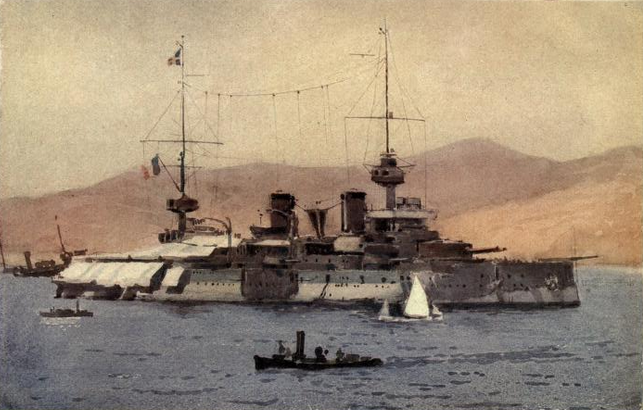
Suffren in the Dardanelles, painting (cc)
Suffren was the last pre-dreadnought before the reforms. They were a further development of the Charlemagne, and closely resembled Iéna with some differences. The ain one was the reintroduction of turrets for a part of the secondary armament, three single guns on either side, plus two in recesses in the hull. Both twin turrets were surelevated. they were the same 12-in (305 mm) 4 caliber modele 1896. The armour was Harvey Steel. Complete belt extending 3 feets 7in above and 4 feets 7 in below the waterline. It was 12 in amidship, tapered down to 4.7 in on the lower edge and reduced after the barbettes to 8 in and finally 4 in. The upper belt of 4.3 in ended on a bulkhead close to the stern, and 6 feets 7 in wide. The belt upper belt level armoured deck was 2.7 in thick, reduced to 2 in forward and aft. The lower deck was 1.6 in thick. Cellular Layer and cofferdam divided the internal spaces and in addition there were four longitudinal bulkheads 2 feet 3 in high on the armour deck to contain flooding.
Suffren was built by Brest, like most last pre-dreadnoughts, between January 1899 and October 1903 when completed, which was substantially faster than the 1890s generation. Sent in the Dardanelles in March 1915, she was hit 14 times. One large caliber hit flooded the forward section by hitting below water, causing some list and a 9.4 in went through a port casemate, putting three secondary guns out of action and starting a fire. It would have cause a large explosion, if not prevented by the ammunition metal boxes and quick reaction from the crew. She survived the campaign only to be sunk by U-52 off the Portuguese coast on her way to Lorient, on 26 November 1916. It seems the torpedo detonated a magazine and she left no survivors.
Specs:
Dimensions: 12,527 tons, 125.50 x 21.4 x 8.38 m
Power: 3 shafts VTE, 24 Niclausse boilers, 16,700 ihp, 17.9 kts, coal 1120 tons
Armour: Main belt 4-12 in, upper belt 4.3-5 in, battery 4 in, casemates 4-6 in, turrets 12.8 in, CT 12 in
Armament: 4x 12 in, 10 x 6.4 in, 8x 3.9 in, 22x 3pdr, 2x 1pdr, 2x 18in TTs
Crew: 714
The great reform and 1900s battleships
Biopic special: Admiral de Lapeyrière
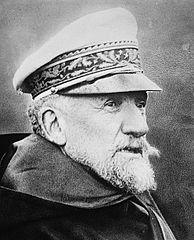 <- Left: Admiral Auguste Boué de Lapeyrière, the French Jackie Fisher. If one name must be advanced to explain and showcase the radical shift in the French Marine National about battleship, it’s this man. Born in the Gers, south of France in 1852 shortly before the Crimean war, and as his father died, he was adopted by his uncle, vice-amiral Dupouy. The latter undoubtedly had a strong effect on the young man’s upbringing and career preferrence. He entered the naval academy in 1869, fought as a fusilier marin (Marine Infantry) in the Franco-Prussian war of 1870, and served on the Armide, D’Estrée and Aspic gunboats in the far east. He ended as manoeuver officer on the Hamelin in 1877-1878, after making world tours in various ships.
<- Left: Admiral Auguste Boué de Lapeyrière, the French Jackie Fisher. If one name must be advanced to explain and showcase the radical shift in the French Marine National about battleship, it’s this man. Born in the Gers, south of France in 1852 shortly before the Crimean war, and as his father died, he was adopted by his uncle, vice-amiral Dupouy. The latter undoubtedly had a strong effect on the young man’s upbringing and career preferrence. He entered the naval academy in 1869, fought as a fusilier marin (Marine Infantry) in the Franco-Prussian war of 1870, and served on the Armide, D’Estrée and Aspic gunboats in the far east. He ended as manoeuver officer on the Hamelin in 1877-1878, after making world tours in various ships.
In 1879, he entered the Rochefort Underwater Defense School as a student, and graduated as a torpedo boat officer. Assigned as a maneuver officer on the Aviso Boursaint in the South Atlantic Division 2, he carried out hydrographic surveys from Montevideo. Lieutenant in August 1881, he commanded in Cherbourg the torpedo boat No. 1, in charge of training. The following year, the Franco-Chinese war broke out and he left for the Far East, as XO (Quartier Maitre) in the cruiser Volta. At the Battle of Fou-Tcheou (Foochow) on August 23, 1884, Boué de Lapeyrère distinguished himself by sinking a Chinese Aviso. From May to July 1883, he participated in operations in the Red River delta (battle of the Pagoda) and under Courbet he was noted for his daring and offensive spirit. Her participated in the action in the port of Mawei and torpedoed the Chinese aviso Fu-Ching, junks and sampans. Appointed as commander of the Vipère, he took part in the battle of Formosa. He also covered the Tamsui landing in October 1884 and by May 1885 conducted the capture of the Pescadores Islands.
He came back in France with awards and recommendations by Courbet. He served on cruiser Seignelay, directed the rescue of the ocean liner Sindh off Piraeus and became at last Commander in November 1889, onboard the cruiser Cosmao in 1890, directing her completion, testing and training. He was second on the battleship Richelieu and Formidable, aide-de-camp in 1895 to vice-admiral, promoted captain in June 1896, his first commission on the battleship Hoche (the North squadron) and a cruiser in the Newfoundland and Iceland division. He captained the Bennus in the Mediterranean until 1990, completing his reputation of a very able seaman. Rear Admiral in 1902 and Major General at Rochefort he was given command two years later of the Atlantic Naval Division. He became member of the technical committee, chairman of the high seas vessels section in 1906 and ultimately vice-admiral in January 1908. By then he had under orders a full naval division, sent to the Baltic. He also became later maritime prefect of Brest. But he is best known for his reforms.
In 1909, Boué de Lapeyrère was called to the Ministry of the Navy under President Aristide Briand’s office. The Navy until then had been plagued by frequent minister changes, and hazardous theories of the “Young School”, plus unsufficient funding and neglect since 1871. The French started as the second in the world, down to the fourth rank, behind USN and Kaiserliches Marine and would have fell to the seventh after the Japanese, Italian and Russian if not reformed. Aware of this massive burden, Lapeyrère took an energetic stance and tried to shake up the old complacent naval administration as well as the yards. His action was facilitated by an unassuming and friendly “southern” attitude in political circles.
His efforts were soon concentrated in three main areas:
-Reorganization of services and support,
-Recruitment and training,
-Construction of modern ships in homogenous class and with internationally sanctioned design recipes.
His first decree came in December 18, 1909.
-This document entirely reorganized the structures of Navy Department, ensuring better coordination between services (many of which were deleted).
-On September 12, 1910, he reorganized the École supérieure de la marine (Navy high school)
-He rejuvenated the staff and appointed a 45-year-old engineer as Head of the Technical Service.
-He also reformed the training of the fleet
-He financed more regular large scale exercises
-The squadrons were also reorganized to be more efficient.
This modernization however was costly, and soon her found a hostile Parliament and indifferent public opinion, never well informed or interested in naval matters unlike in Britain.
The naval law of 1910 at last was aimed at procuring homogeneous series of battleships, cruisers but also torpedo boats. This was a massive investment the government agreed but did not dare present it to the Parliament, by fear of a distrust vote and fall of the cabinet.
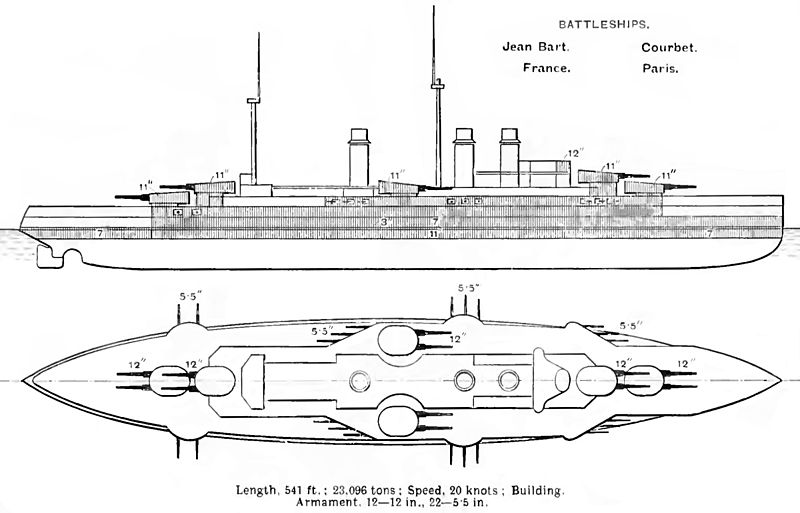
The Courbet class, ordered as part of the ambitious 1912 naval plan.
But presented the right way, this plan in part succeeded, despite delays. Even before him in 1900, his advocacy of reforms and critics of the Young School led the Navy minister to order six large battleships of a very similar design, larger, faster and with a better range than anything which came before, the Republique/Liberté class as well as the first semi-dreadnoughts of the Danton class. Boué de Lapeyrière saw the construction of the Danton as an error however, and pressed for the adoption of French’s first dreadnought as soon as possible.
He ordered in a row the Courbet, Bretagne class (which all saw action in both wars), and the Normandie and lyon classes. On the cruiser’s side, he could do little as the last were completing when he entered his office, as the Cruiser program was curtailed after the launch of the Dreadnought. But he pressed not only for the adption of battlecruisers (Durant-Viel and Gills studies from 1912) and light scout cruisers as well. He also pushed for the creation of more coherent destroyer and submarine classes, and curtailed torpedo contruction which he considered obsolete;
His masterstroke was his 1912 naval program, which should have given France around 1920, twenty four capital ships (sixteen dreadnought and eight battlecruisers) but the Great War aborted these grand plans.
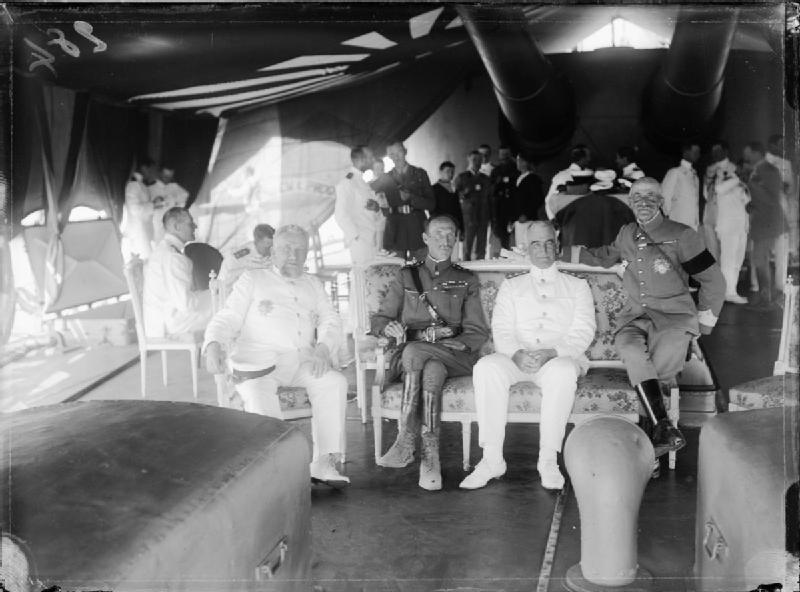
Allied commanders aboard hms queen elisabeth in 1915 – The gallipoli campaign. De Lapeyrière is first from the left, seated next to Ian Hamilton and John de Robeck.
Lapeyrière left the ministry already in 1911. He basically was the last general officer at the head of the ministry before the War, and was appointed by the naval staff in August 1911 as commander of the first line squadron, later called the “first naval army”. He pushed the training of this force to very high standards, in accordance to the Franco-English agreements of 1912. The latter indeed tasked the French to concentrate their forced in the Mediterranean, against the Austro-Hungarian fleet and possible hostility of Italy, allowing the Royal Navy to leave there only two local squadrons, in Gbraltar and Alexandria, concentrating on the Grand Fleet and the north sea.
The German fleet was indeed the main opponent. In August 1914, Boué de Lapeyrière became the interallied Commander-in-Chief in the Mediterranean, protecting sea lanes, and the transport to France of the XIXth Army Corps from Algeria, while watching the Austrian fleet. He could not prevent the German cruisers Goeben and Breslau of escaping towards Constantinople. For this he earned the most serious reproaches of his career. His naval force was soon in action on the Adriatic, ready to intercept the Austro-Hungarian fleet. His force sank the cruiser Zenta off Antivari in August 1915, but sorties were rare. His ships however tried to provoke this sortie by bombarding Cattaro and land troops on the Dalmatian Islands, while destroying all semaphores and military structures in the area.
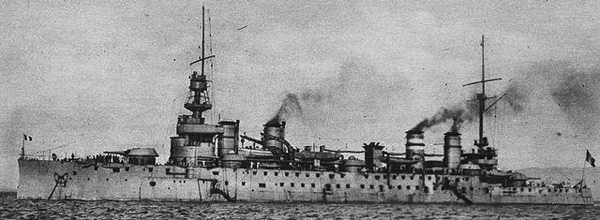
The cruiser Leon Gambetta, unknown origin (wc)
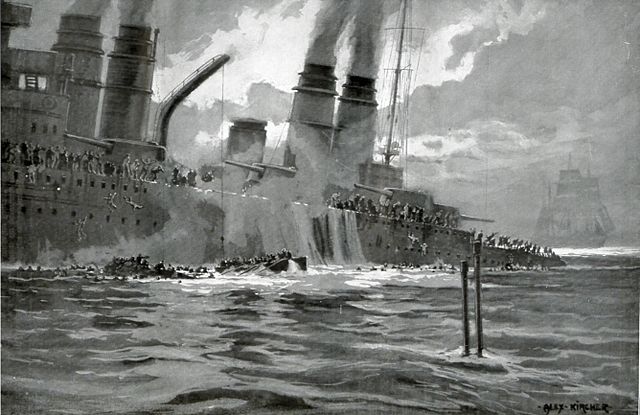
German postcard depicting the sinking of the Leon Gambetta (cc)
Ha also put in place the blockade of the Otranto, came to the aid of Montenegro and managed to adapt his forces to the increasing submarine threat along the way. His strategy however was considered too timid given his much superior forces, notably by Vice-Admiral Bienaimé. Léon Gambetta was sunk in the Adriatic on April 27, 1915 and Lapeyrière was held personally responsible for it as well. Sick of this, Boué de Lapeyrère eventually resigned in October. He joined the reserve in March 1916. After retiring from the navy and brielfy tried politics he retired in Pau where he died on February 1924.
République class (1902)
République, Patrie
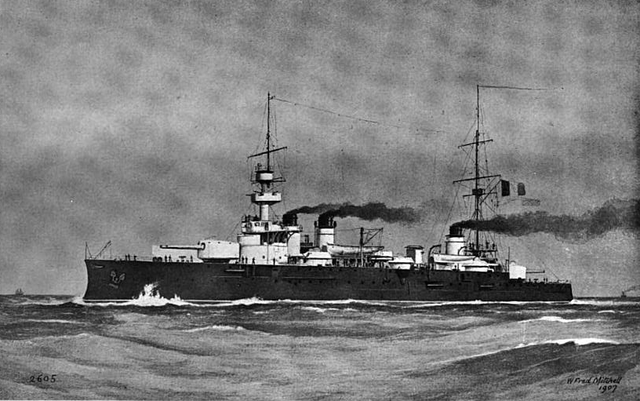
Republique – Brassey’s naval annual
The many shortcomings of the previous classes had been highlighted and for the first time, a homogeneous class of battleships had been started, designed in 1899. As a result, the two first ships, République and Patrie were not launched until 1902-03 and completed in December 1906, and were already outdated as HMS Dreadnought had just come out. However, they were a significant improvement over previous classes in many areas, with 1.5 more displacement, better secondary armament in turrets, more conventional main artillery and hull. The next four were basically copies, but there were still enough differences for most historians to place them apart.
Development & design:
The two pre-dreadnought were ordered as part of a naval expansion program to answer German warship construction in 1898. The French program called for six new battleships. The last four became the Liberté class, improved copies of the first. République and Patrie were designed by famous French naval engineer Louis-Émile Bertin. They were a significant improvement over previous designs, carrying four 305 mm (12 in) guns, eighteen 164 mm (6.5 in) guns now mounted in gun turrets and not in casemates. This make their use more flexible as they had a much better arc of fire and were well above the sea, therefore still efficient in heavy weather. The ships also had a more effective armor protection arrangement and calculations were flawless, so when fully loaded they stayed at their opetimal draught, without consequence for their armour belt’s height. Stability was good and additional protections had been done in case of flooding.
In the end, they were better than previous classes, but were a generation late already. They should have been built ten years before. Construction was slow, due to frequent changes to the design while under construction, a typical problem in French naval construction that was only solved shortly before WW1. Because of this, they were completed in December 1906, while Dreadnought was in construction. Added to this, the next Liberté were a copy of the first, so further delaying new constructions until 1904-1907, completed in 1908 while the British, US, Germans already had their own dreadnought classes completed and were building more. To add insult to injury, the class after this, started in 1907, were still pre-dreadnoughts ! (see explanations later)
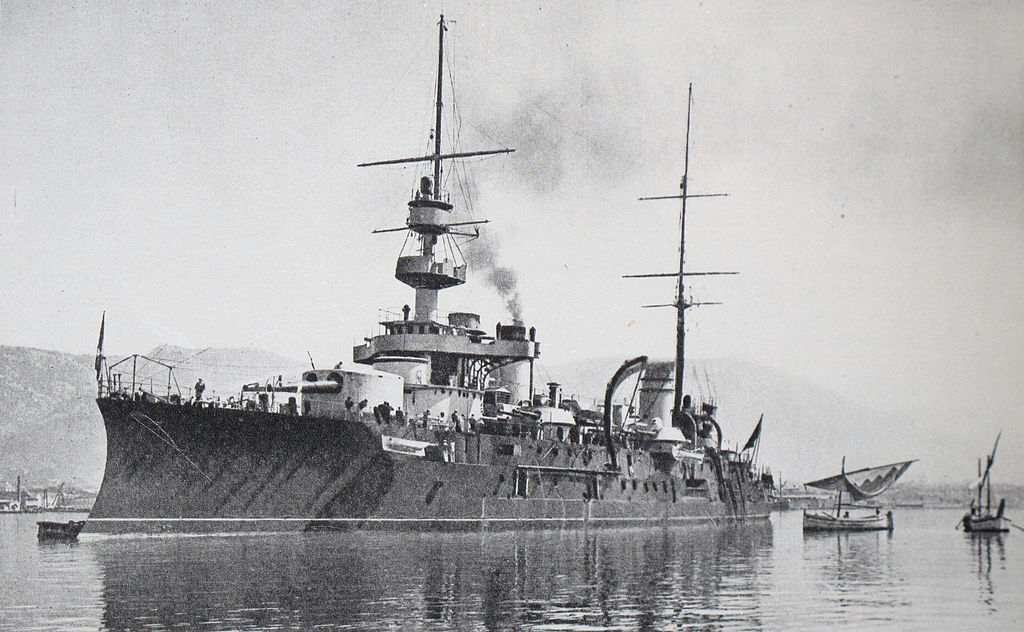
The République in service:
Both ships entered service with the fleet in 1907, whereas HMS Dreadnought was already commissioned, making all pre-dreadnoughts obsolescent. They became the front-line units in the French fleet for most of their careers, including half of WWI, replaced by the Bretagne class. Their peacetime careers was uneventful, a routine of training exercises and ports visits overseas, naval reviews for French politicians and foreign dignitaries. In August 1914 they were in the Mediterranean naval division, escorting troopships convoys with the French Army from French North Africa to France. Reinforcing the front, they allowed the Marne taxis eposide to take place, saving the day. Republique and patris then joined the main fleet, in faction for any sortie of the the Austro-Hungarian Navy. The only significant action wax the Battle of Antivari in September 1915 when the French caught and sank SMS Zenta.
The battleships patrolled the southern end of the Adriatic Sea until the Otranto barrage was set in place. However like for the Italians, repeated attacks from Austro-Hungarian U-boats forced them to be sent at a safer place. Patrie participated in the Gallipoli campaign, in May 1915. She was followed by République in January 1916, cover the Allied evacuation. The two battleships intervened in Greece, assisting the coup against the pro-German Greek government. République and Patrie were sent in Mudros to guard from any sortie of the Germans in Constantinople in the aegean. They saw no further action and by January 1918, République saw two of her 12 in guns removed and sent to the army while she became a schoolship. Patrie was also converted as a training ship after the war. The first was decommissioned in 1921, BU in Italy, and Patrie was maintained until 1936 before decommission and sold in 1937.

Specs:
Dimensions: 14,605 tons st., 133.81 x 24.26 x 8.41 m
Propulsion: 3 shafts, 24 Niclausse boilers, 18,000 shp, 19 knots.
Armor: belt 280, turrets 350, CT 300, turrets sec. 152 mm
Armament: 4 x 305, 18 x 162, 25 x 47 mm, 2 TT 457 mm aw.
Crew: 825
Liberté class (1904)
Liberté, Justice, Démocratie, Vérité
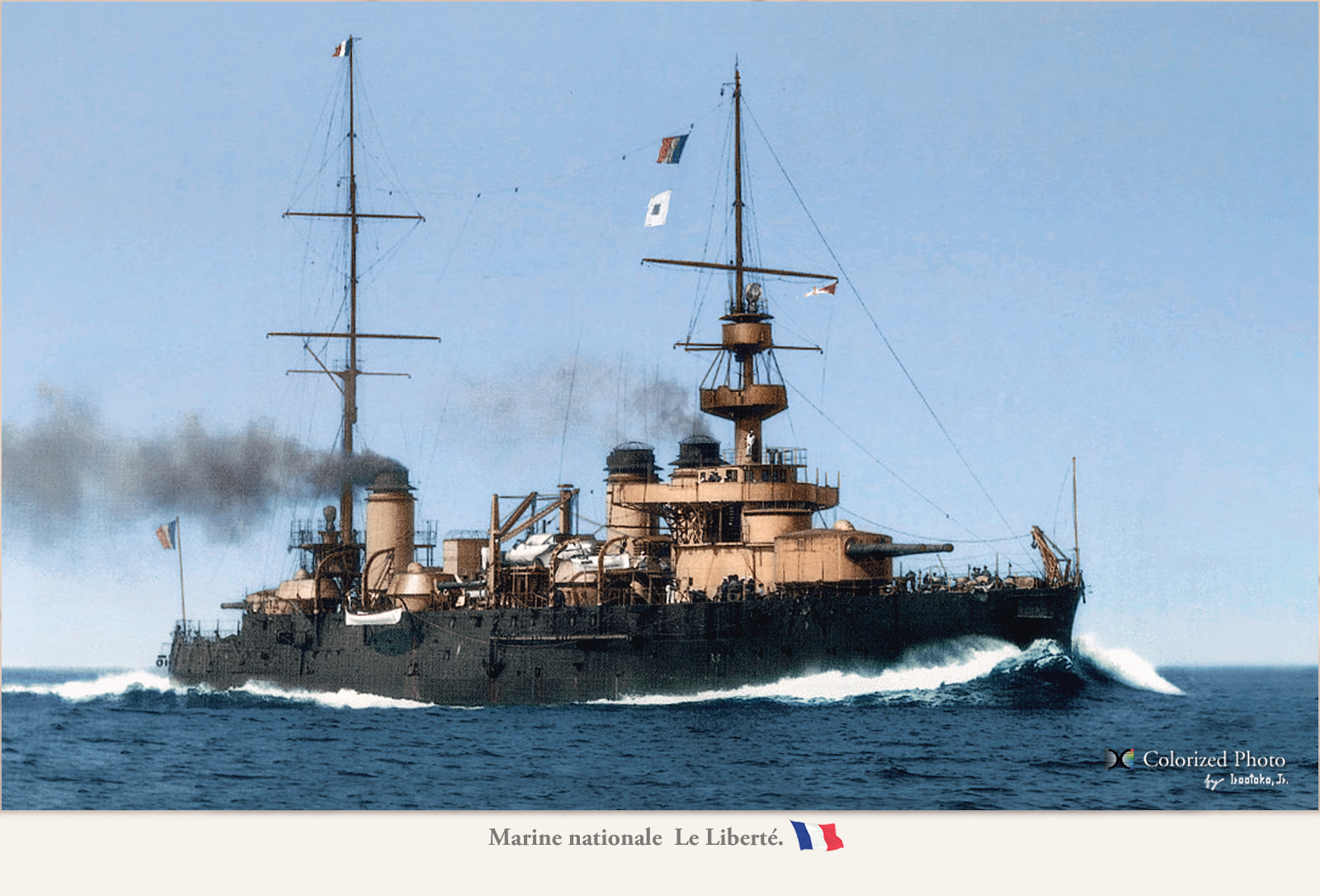
Battleship Liberté 1904, colorized by Irootoko Jr.
Design development
The Liberté class were pre-dreadnought ordered as part of the same naval expansion program as the prevous République. During construction of the first two, adoption of heavier secondary batteries for the last pre-dreadnoughts (called “semi-dreadnoughts”) prompting the French to re-design them to carry a more powerful secondary battery with 194 mm (7.6 in) guns in turrets, so making a new class called the Liberté class. These heavies guns were in six single turrets, the remainder four in casemates. They were still not true “semi-dreadnoughts” compared to the Danton class as they were still equipped with VTE engines, lacking turbines. Armour wise, it was the same scheme with the only difference being the barbettes bases, 3.5 to 5.5 inches thick. Justice was about 400 tonnes heavier, and Liberté had a mixed anti-torpedo armament, with 9-pdrs of a new pattern.
These ships were built at Brest (Démocratie), La Seyne (Justice), Ch. de la Loire (Liberté) and Ch. de la Gironde (Vérité) between 1902 and 1908, launched in 1904 to 1907. Much too long compared to international standards and all obsolete when commissioned.
The Liberté class in service
Their peacetime careers were largely uneventful. Like the previous ones, they were first line and alternated time between training exercises, ports visits, and naval reviews. In 1909, Liberté, Justice, and Vérité made a noted visit to the United States, marking their participation to the Hudson–Fulton Celebration. Liberté never saw WWI: She was destroyed by an accidental explosion, caused by unstable propellant charges in the port of Toulon in 1911. The result of the enquity prompted the naval staff to enforce strict constrols and handling procedures for the storage of nitrocellulose propellant, and notably better cooling. The three other ships escorted troop convoys from North Africa in August 1914, and joined their sister-ships of the Liberté class in the armée naval posted south of the Adriatic Sea. Despite attempts to bring the Austro-Hungarian Navy out to battle, this never happened. They participated in the Battle of Antivari but were later retired from the area due to the threat of submarines. Vérité was sent to the Dardanelles in September 1914 and shelled Ottoman coastal defenses.
In 1916, the three sisters came to Greece, pressuring the neutral government to join the Allies, and assisted a coup overthrewing the king, bringing the country to war. They were then based in Corfu mostly inactive due to coal shortages. After the war, Justice and Démocratie joined the Black Sea dueing the recolution, monitoring German forces and demilitarization of Russian warships seized. Vérité also was sent to Constantinople, overseeing the Ottoman surrender. By mid-1919 they sailed back to France, Vérité decommissioned and the other two in 1920, sold for BU in 1921.
Specs:
Dimensions: 14,500/14,800 tons standard, same dimensions
Propulsion: 3 shafts, 22 Belleville boilers, 18,500 shp, 19 knots, coal 1800 t.
Armor: same
Armament: 4 x 305mm, 10 x 193mm, 13 x 65mm, 10 x 47mm, 2 TT 457 mm aw.
Crew: 769-840
Danton class: First and last semi-dreadnoughts (1909)
Danton, Condorcet, Mirabeau, Vergniaud, Diderot, Voltaire
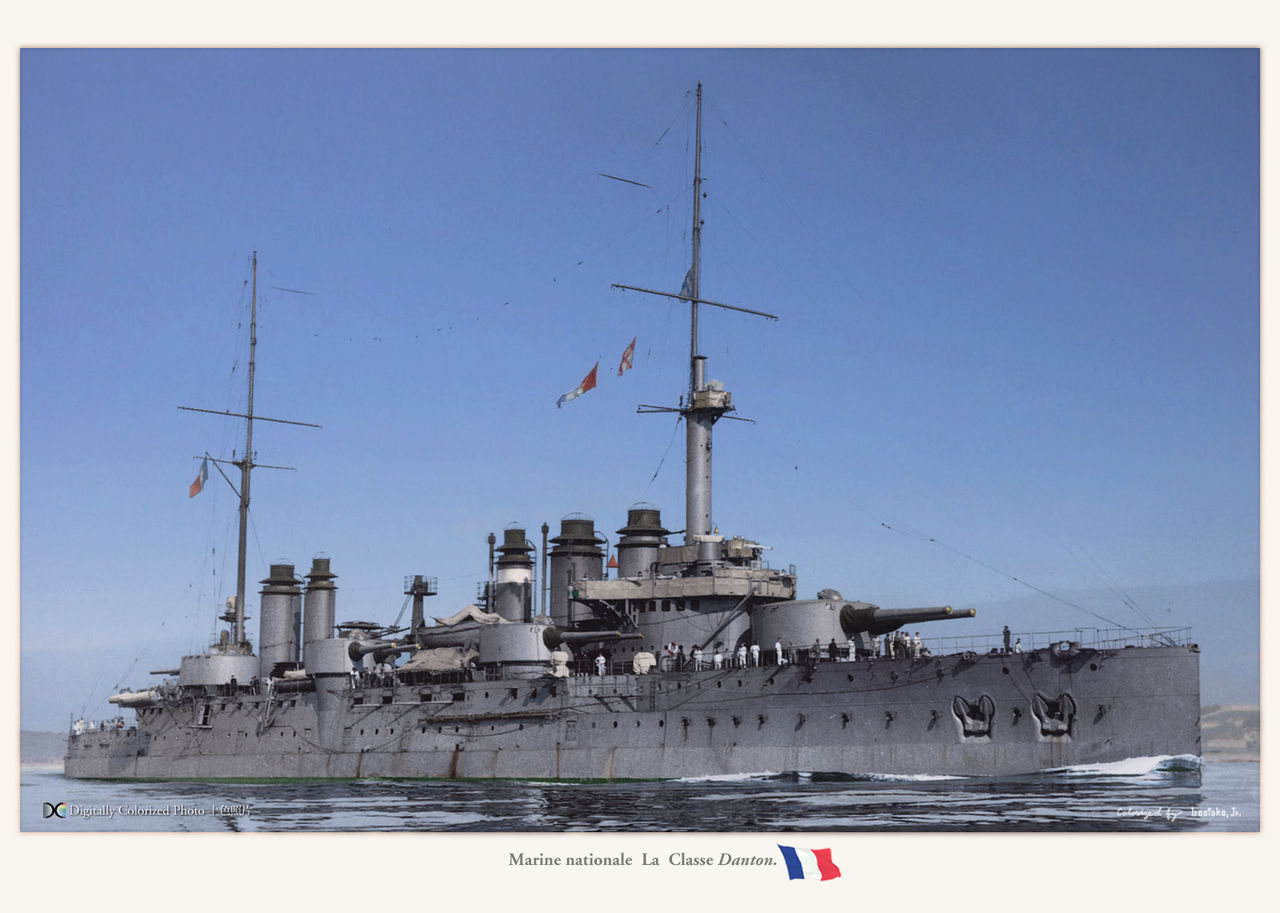
Battleship Danton, colorized by irootoko jr.
Design & construction:
These were the last French pre-dreadnoughts, designed by chief engineer Lhomme for the 1906 program. They had the misfortune of being ordered in various yards from June 1907, even as HMS Dreadnought was commissioned, and successors in construction. The 1900 naval plan went on however as these ships were much faster, having turbines, but were still too limited by their displacement to adopt an all 305 mm armament became true dreadnoughts. These 6 ships were all completed in 1911, while the Courbets were started. Obsolete, the Dantons nevertheless were much larger and faster than their predecessors with 18,300 tons instead of 14,800, using also the first turbines installed on a French battleship. With 19.5 knots (20.6 knots in tests). Some had Niclausse (Condorcet, Vergniaud, Diderot) and others Belleville boilers, and based on 22,500 shp they reached between 19.2 and 19.4 knots, while carrying up to 2030 tonnes of coal in wartime. This allowed them a radius of 3370 nm at cruiser speed of 10 knots, down to 1750 at 18 knots.
They were still not fast enough as the first Dreadnought and its successors (21 knots), but there again, because of their limited dislacement. A larger size would have ensured to cram more boilers, but they would have perhaps gained only one knot, as they were bad steamers, with high consumption and small range. Based in the Mediterranean, this was less a problem though. Their secondary armament progressed considerably, from 196 to 240 mm (10 inches), which were still fast-firing and had almost the same range as the 305 mm. So they are recoignised as France’s only semi-dreadnoughts, transitional battleships.
They also used the new British Barr & Stoud firing control system found in HMS Dreadnought allowing a theoretical range for their 240 guns from 13,700 to 18,000 meters. Their rate of fire was also very good, firing tests proving the validity of this weapon combination. Armor however did not progressed much, but tertiary armament was much reinforced at the start of WWI. They obtained 12 additional 3-in guns (75 mm) mounted on the turrets with high elevation mounts enabling AA fire. All these ships were completed in 1911, already obsolete. They were the last pre-dreadnought built in any navy.
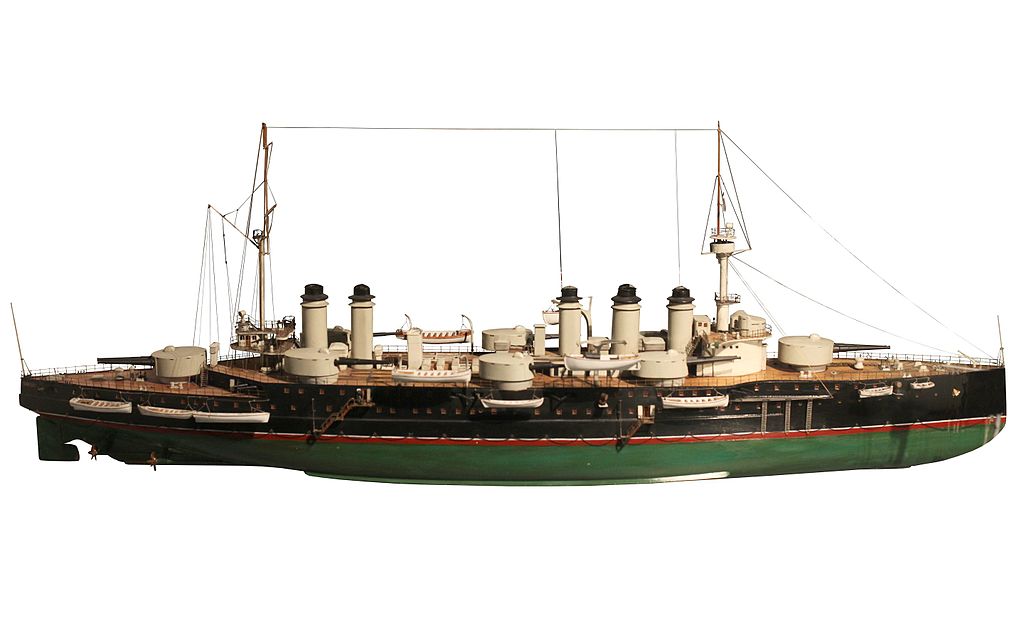
Model of Danton at the Paris maritime museum
Wartime career:
Their career was not spectacular, and Danton was the only lost during the war, torpedoed by the U-64 in south of Sardinia. Voltaire survived in 1918 after being torpedoed by UB-18. These battleships were presed into the 1st armée navale, roamed the adratic for a short time, and later were sent to Greece, fired warning shots against the Greek government in Athens, to force it to swap side to the allies. Diderot, Vergniaud, Voltaire and Mirabeau formed later with the ships of the Liberté class the Aegean Sea squadron. They deployed against the Austro-Hungarian fleet close to the otranto barrage, ready for any sortie of the fleet in Pola. On November 13, 1918, they were stationed in Constantinople as a way of pressure during peace negociations. Vergniaud and Mirabeau left the Crimea in 1919, shelled Sebastopol by now in the hands of the “reds”. Mirabeau suffered a storm was grounded. She was refloated and towed away in 1919. Never repaired, she became as an experimental pontoon. The others underwent some modernizations to serve in the interwar, starting in 1922-25. Underwater protection in particular was overhauled. Condorcet, Diderot and Voltaire spent the rest of their careers as training ships. Condorcet was the last one still extant during WW2, she was scuttled in Toulon in November 1942, and sunk by the Germans in 1944 during Operation Anvil Dragoon. More on these on the upcoming post on French WW2 battleships.

Author’s rendition of the Danton class.
Specs:
Displacement: 18,320t standard, 19,760t Fully loaded
Dimensions: 146.6 x 25.8 x 9.20 m
Propulsion: 4 shafts Parsons turbines, 26 Belleville or Niclausse boilers, 22,500 hp. 19.6 knots
Armor Protection: 45-300 mm
Armament: 4 x 305, 12 x 240, 16 x 75, 10 x 47, 2 x 457 mm TTs bd sub
Crew: 681
French Dreadnoughts
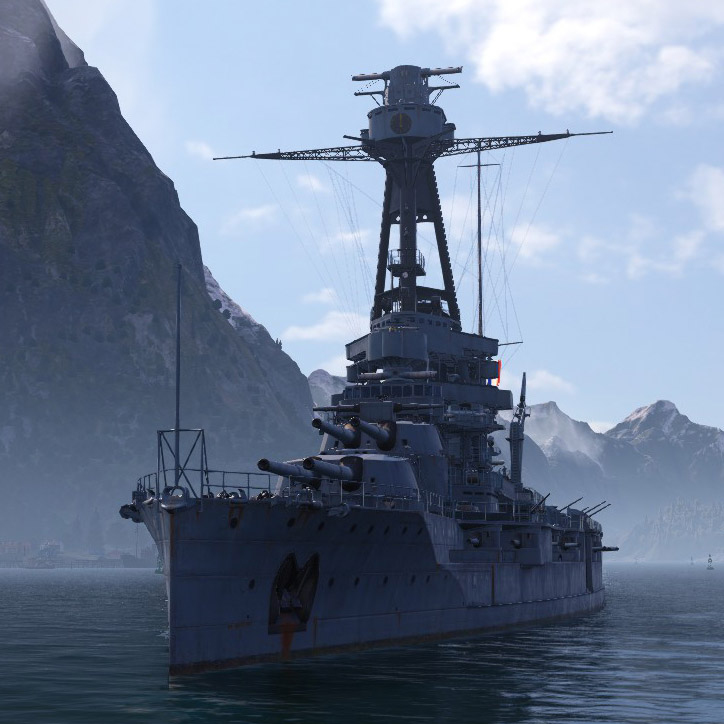
Due to the late order of the Danton class, laid down well after HMS Dreadnought was launched, in the summer of 1907. France took four years of delay before starting its first dreadnoughts. Part of this was it was already too late to change the design, and the idea of a powerful two-stage secondary artillery which compensated by the lack of an uniform 12-in battery by speed. Most historians recoignised now that it had two main reasons: French analyses of the Russian defeat at Tsushima in 1905, which credited the IJN victory to their large use of medium-caliber hits as the battle was close enough for this, and set the Russian superstructure ablaze. For this, the French considered the 240-millimeter (9.4 in) gun was a good compromise to a true 12-in. They had about the same range and were almost twice as fast.
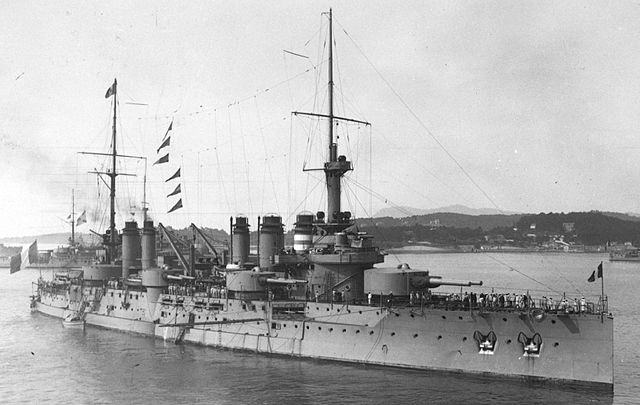
Voltaire in Toulon, agence Rol, Gallica (cc)
They also recoignise Britsh innovation for speed, and adopted turbines for the first time. Construction however was delayed and crippled by the new Minister of the Navy, Gaston Thomson, which wanted budget cuts and constantly interfered with construction, ordering more than 500 modifications to reach an inferior limit of 18,000-metric ton. Builders had to scrap entire sections and rebuilt them. Proponents of a conversion to 12-in calibers were not heard as the displacement limit would have been exceeded. Needless to say, Boué de Lapeyrière was no longer there to change the outcome and could only enrage so see his ambitious naval plan curtailed and delayed by short view politicians. History is cruel, and in the end France entered WW1 with no less dreadnoughts than… Austria-Hungary.
Intermediate projects

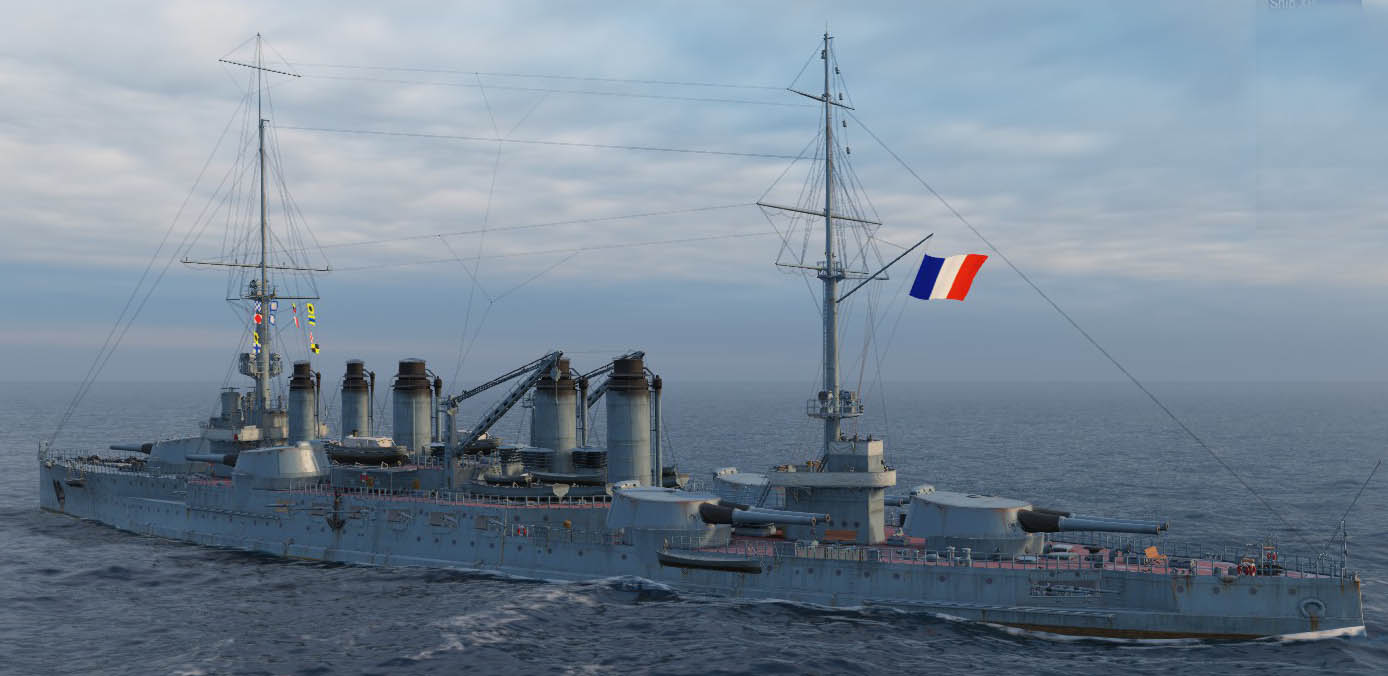
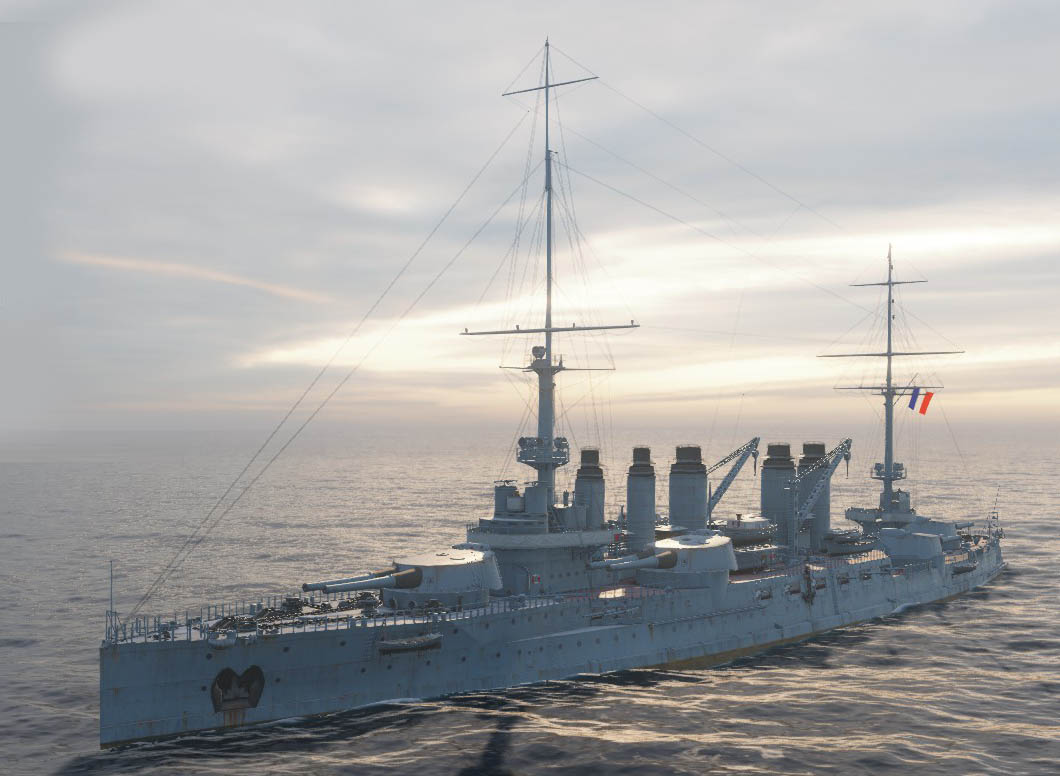
The “Turenne” a ficticious dreadnought battleship proposed by world of warships. It is actually presented as if the Danton design had been successfully modified to carry 12-in guns instead of its 240 mm battery. In this guise, it is shown with the classic early configuration of one forward and one aft twin turret, and four side turrets. For this, the lenght would have been uncharged but the beam would have been pushed from 25.8 to 27 or 28 m. The loss in speed would have been compensated by stacking more boilers in this aditional beam. Still, they would have been slower than the standard of the time, but at least France would have fielded six dreadnoughts in 1911. Fully loaded displacement would probably have been around 21,500 tonnes. However at the time the parliament and navy minister fixed a standard limit at 18,000 tonnes only, condemning the plan. The 1910 plan as approved however succeeded in having this limit pushed up to 22,000 tonnes, the only realistic way to get a sustainable dreadnought design. Unfortunately for the French, this was still not enough for a heavier artillery than 12-in.
The development of dreadnought design proceeded in an incremental way under the leadership of the new minister of the navy, Augustin Boué de Lapeyrère. Unfortunately it’s extremely hard to find any blueprints or alternative designs for the Courbet class. So we basically have no clue about the alternative designs that preceded the final Courbet as we know it. It seems it leaped forward directly from the Danto to the final design, with superfiring turrets allowing to cram more turrets in the same space. The reason why the two classes of dreadnoughts (Courbet and Bretagne) used the same hull was of course to save development time, but also because of existing yard basin size. One only was larger at St Nazaire and could have authorized much larger vessels, but an unifrm class of four ships was needed built in concert, so the four yards concerned had to have at least a 180 m long basin.
Courbet class (1911)
Courbet, France, Jean Bart, Paris
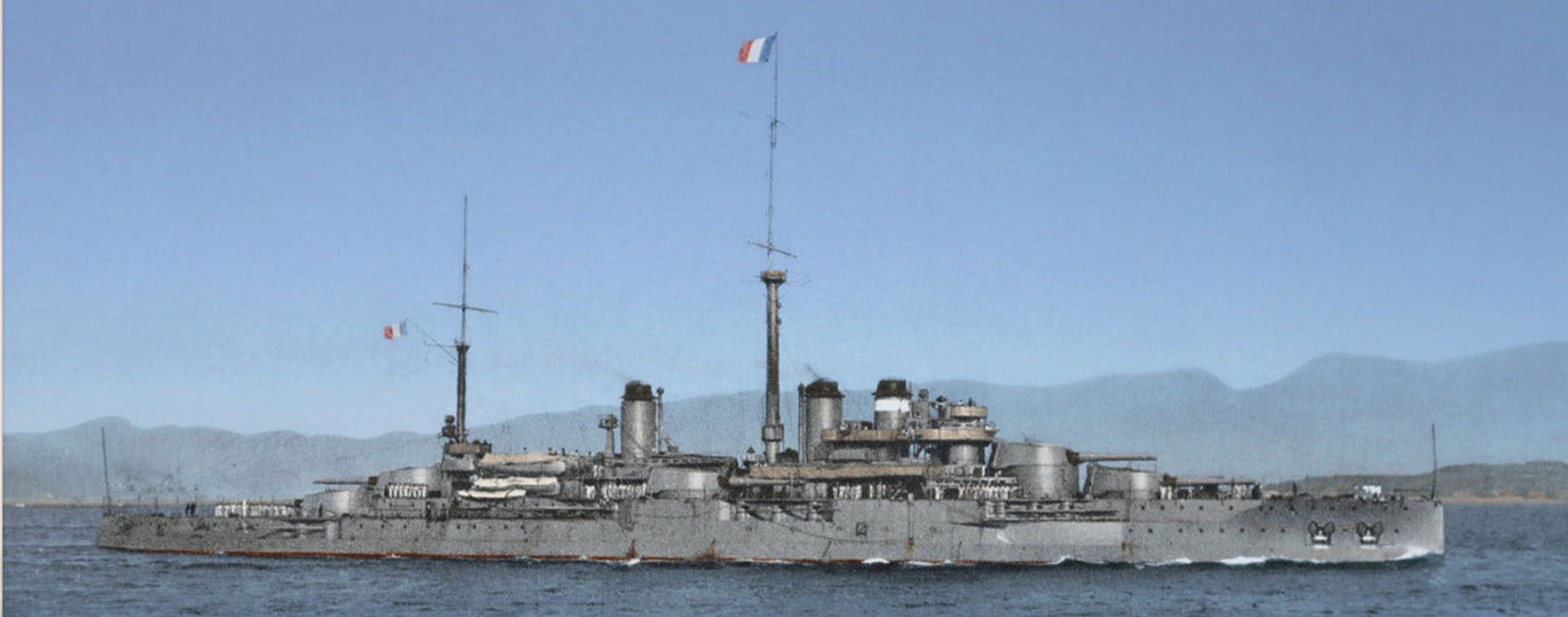
Courbet, colorized by Irootoko Jr.
The Five Courbet class ships were the first French dreadnought battleships. They were started late due to the scheduled completion of the six Dantons. This delay, moslty because of political reasons, which was considered much unfortunate in the dreadnought race that started in 1906. But the 1912 program established by Admiral Boué de Lapeyrère, aimed to give France 12 other dreadnoughts before 1918. The war would decide otherwise. The Courbet class consisted of four ships, the Courbet and Jean Bart of the first tranche, started in 1910 in Brest, launched and completed in 1913 and the other two, France and Paris, in St Nazaire and La Seyne in Toulon. The latter were not operational until August 1914, when hostilities began: As a result, France only aligned 2 dreadnoughts in its fleet on that date against 13 for the Hochseeflotte and 22 for the Royal Navy.
Design
Designed by engineer Lyasse, these ships had much beter armor protection than the Dantons, but still inferior to that of the British, American, and German ships. Their staggered artillery arrangement resumed a classic configuration on French battleships, which gave a chase or retreat eight pieces capability, ten in broadside, for 12 in total. But in 1914, the 12 inches (305 mm) caliber had already been exceeded but by Germany, and lead navies went towards the 14 in (343 mm) caliber. It was intended for the next Bretagne class, built in emergency on the same hull. The Courbets could be recognized by their three funnels separated by their main mast. Their secondary armament remained below the standard caliber of other navies (5 inches) and their anti-torpedo boat artillery was modest. But these 138 mm casemates precisely fulfilled the role of close defense thanks to their much higher rate of fire. Relatively good walkers, these ships reached 22.6 knots, quite an improvement over the Danton. They carried 100 shells for each 305 mm gun and 275 for each 138 mm. They had been designed to lay 30 mines also, which never happened.
Career
The four Courbets were sent to the Mediterranean in 1914 (Paris was already making its first operational outings there). Courbet received the mark of Admiral de Lapeyrère, and two additional projectors were added on platforms on the second funnel. They served intensely, Jean Bart taking a torpedo from U 12 in December 1914 in the Adriatic, but without much damage. France and Jean Bart were sent to Sebastopol assist disarm the Russian fleet in 1919. At that date, these four battleships were now obsolete, making it even difficult to modernize. They ploughed heavily in heavy weather, but it was not possible to lengthen or modify them for lack of suitable dock. The battleship France struck a reef and sank in 1922 near Quiberon. The three others, partially modernized, were used as a training ship in 1939. Click the title link to access the main article.
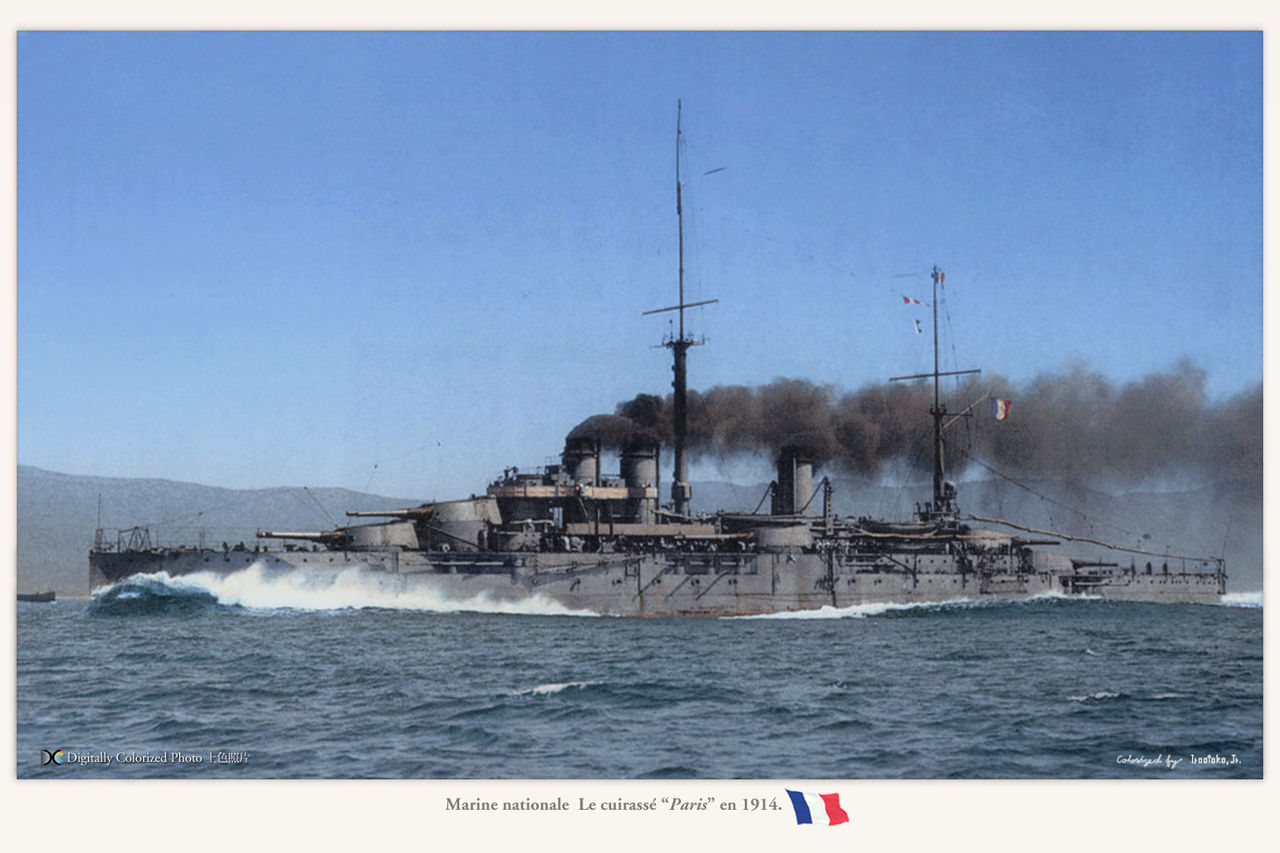
Batteship Paris, colorized by Irootoko Jr.

Specs:
Displacement: 22,200t. 26,000 FL
Dimensions: 165.9 x 27.9 x 9 m
Propulsion: 4 shafts Parsons turbines, 24 Belleville or Niclausse boilers, 28,000 hp. 20 knots
Armor: belt 270 mm, turrets 320 mm, CT 300 mm, barbettes 270 mm, decks 20-70 mm
Armament: 12 x 305, 22 x 138, 4 x 47 mm and 4 x 450 mm TTs sub bd.
Crew: 1108
Provence class (1913)
Intended to replace the old battleships derived from Charles Martel, the three dreadnoughts of the Bretagne class (with Provence and Lorraine) were defined in the Lapeyrère plan of 1912. To save time, they were based on the hulls of the four previous Courbet, but their artillery arrangement and caliber was more modern: It consisted of five twin turrets with 13.4 in (340 mm), all in the axis. As the central amidship turret could only fire on broadside, this gave limited firepower in chase or retreat. Started between March and August 1912 in Brest, St-Nazaire and Lorient, they were launched in 1913 but completed during the Great War: Provence in June 1914, Bretagne in September 1915 and Lorraine in July 1916.
They were also the last French battleships equipped with Bullivant steel nets from their conception, withdrawn in 1917. Their underwater protection was otherwise passable, but their internal compartimentation, fire guidance and control equipment were excellent. The range of their guns was also passable, 14,500 meters at most, but increased to 18,000 at the end of the war by modifying the mounts. Their radius of action was also limited, but their Mediterranean theater of operation still suited it. Their career was very active: Bretagne was engaged in Greece, and the two others in multiple theaters of operations. Their interwar was ww2 career is also consequent. Click the title link to access the main article.
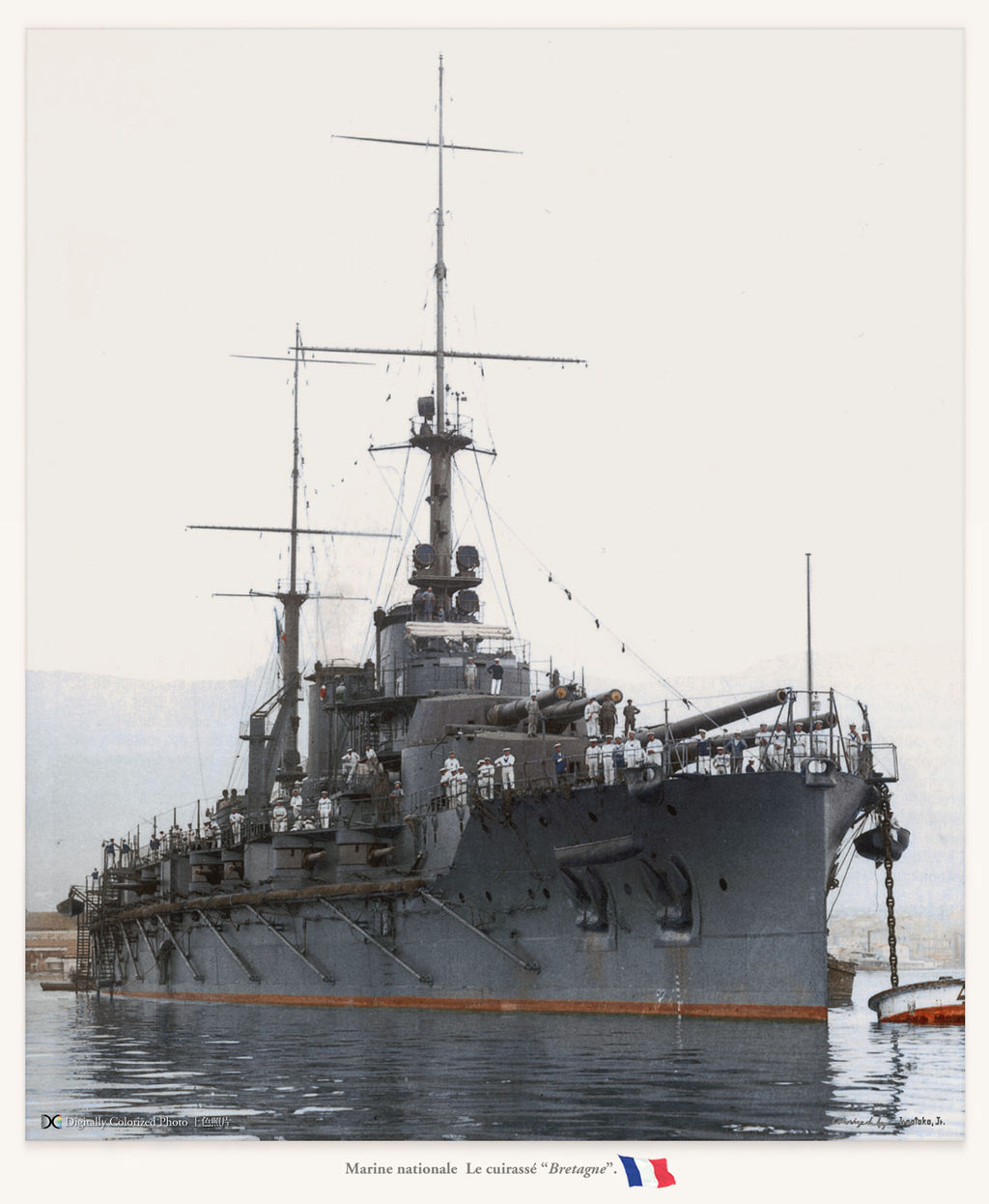
Bretagne, colorized by Irootoko Jr

Specs:
Displacement: 23 230 t. 25,000 t. FL
Dimensions: 166 x 27 x 9.8 m
Propulsion: 4 shafts 2 Parsons turbines, 24 Niclausse boilers, 29,000 shp, 20 knots.
Armor: 400 mm turrets, 40 mm decks,
Armament: 6 x 340, 22 x 138, 4 x 47, 4 x 457 mm TT sub, 30 mines
Crew: 1133
Normandie class (1915)
Normandie, Bearn, Flandre, Gascoigne, Languedoc
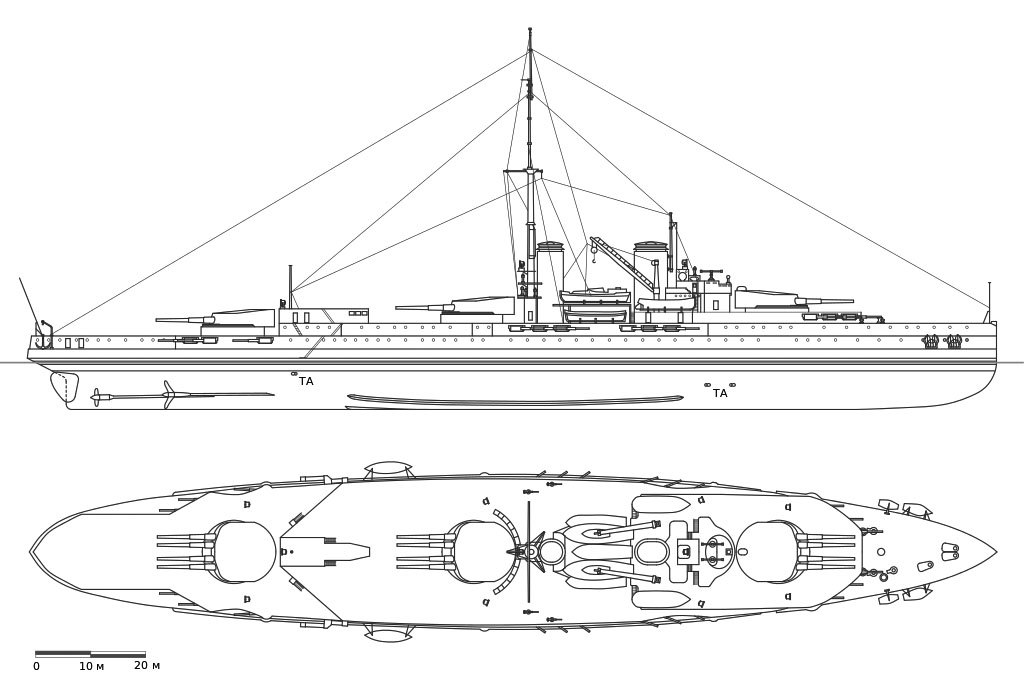
If France has maintained its naval construction programme initiated 1912 until its conclusion in 1918, the fleet would have seen the adjunction of nine brand new battleships and eight battlecruisers to boot. And the last ones would have been the heavily armed battleships ever designed. Unfortunately the Navy always had been the poor child of budget spending. Because of manpower and resources were needed to bolster gun and ammo production, shipyards were virtually drained dry and all constructions were suspended. The third French dreadnought class was a clear departure over the previous design. Without the time to develop a 15-in gun (380 mm), the French choose another path, more guns, and at the same time a rationalization or armour. Engineers were aware of the lack of protection of preceding dreadnoughts and devised the best way to concentrate a heavier armour. They chose a path that would be a cornerstone of french capital ship design until WW2, notably with their trademark quadruple turrets.
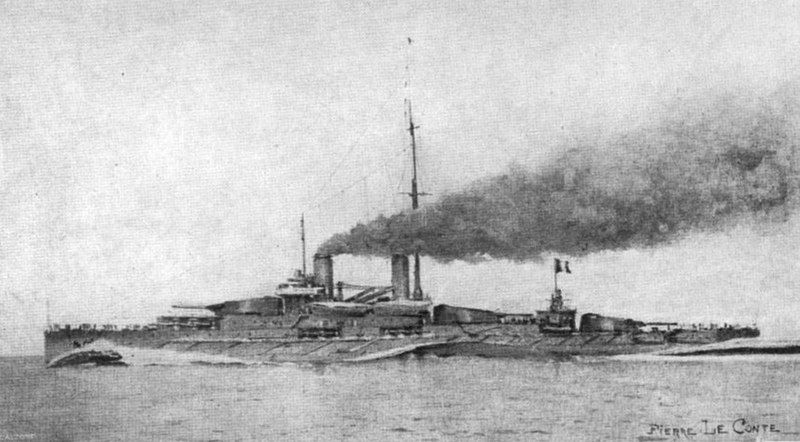
Artist’s impression at the time of the Normandie class
This led to the design of the Normandie class, submitted, accepted and ordered in December 1912 for the first two and July 1913 for the next two and final one in December 1913, all named after French régions, ancient historical Duchies, pursuing the tradition the previous class. What really makes this class stand out are the choices made for their artillery and protection as well. The twelve 340 mm (13.4 in) main guns were mated in three quadruple-gun turrets, the first of their kind. This arrangement saved weight, and all three were lighter combined than the five twion turrets of the previous Bretagne. Not only it saved on weight overall, but allowed to concentrate armour where it really mattered. The design was also marked by the desire of obtaining a better range, a critic of all previous French Battleships. Therefore the first four were to be equipped with an unusual hybrid propulsion. It combined steam turbines and triple-expansion steam engines. The result allowed to increase fuel efficiency considerably. Another design originality, eventually dropped as too complex, was the adoption of double casemate mounting (like for the Borodino class battlecruisers). They would have been mounted in tandem, one at battery deck level, and others above in the superstructure. Instead, six were arranged in recessed on either side and the remainder in the lower deck aft, or evelated in a unusual (but also characteristic) forwatrd superstrcture which also supported the barbette. This made them at three levels. The model was still the trusted 5.4 in (138 mm) QF gun, two more than for the Bretagne.
Their powerplant comprised two 4-cyl Triple Expansion engines driving the outer shafts, mostly for cruising, and two Parsons turbines (on Gascoigne Rateau-Bretagne and Schenider-Zoelly for Languedoc). Béarn, the last ordrered, was a bit different as she had only turbines. All used small tubes boilers, either Guyot du Temple (Gascoigne, Normandie), Belleville (Flandres, Languedoc) or Niclausse (Béarn). Projected output as designed was 32,000 shp (compared to 29,000 previously) for 21 knots, still inferior to 1913 British first ‘fast battleships’ capable of 23 knots, but a modernization in the mid-1910s was intended to push this to 45,000 shp for 22 to 23 knots. They carried 900 tonnes of coal in peacetime, up to 2700 in wartime, plus 300 tons of oil (again, peacetime figure). Range was estimated to 6500 nm at 10 knots, much better than the previous Bretagne. This fell to 1800 at a sustained full speed. Nevertheless, this arrangement was later found unsatisfactory, perhaps explaining why th Béarn was given four turbines.
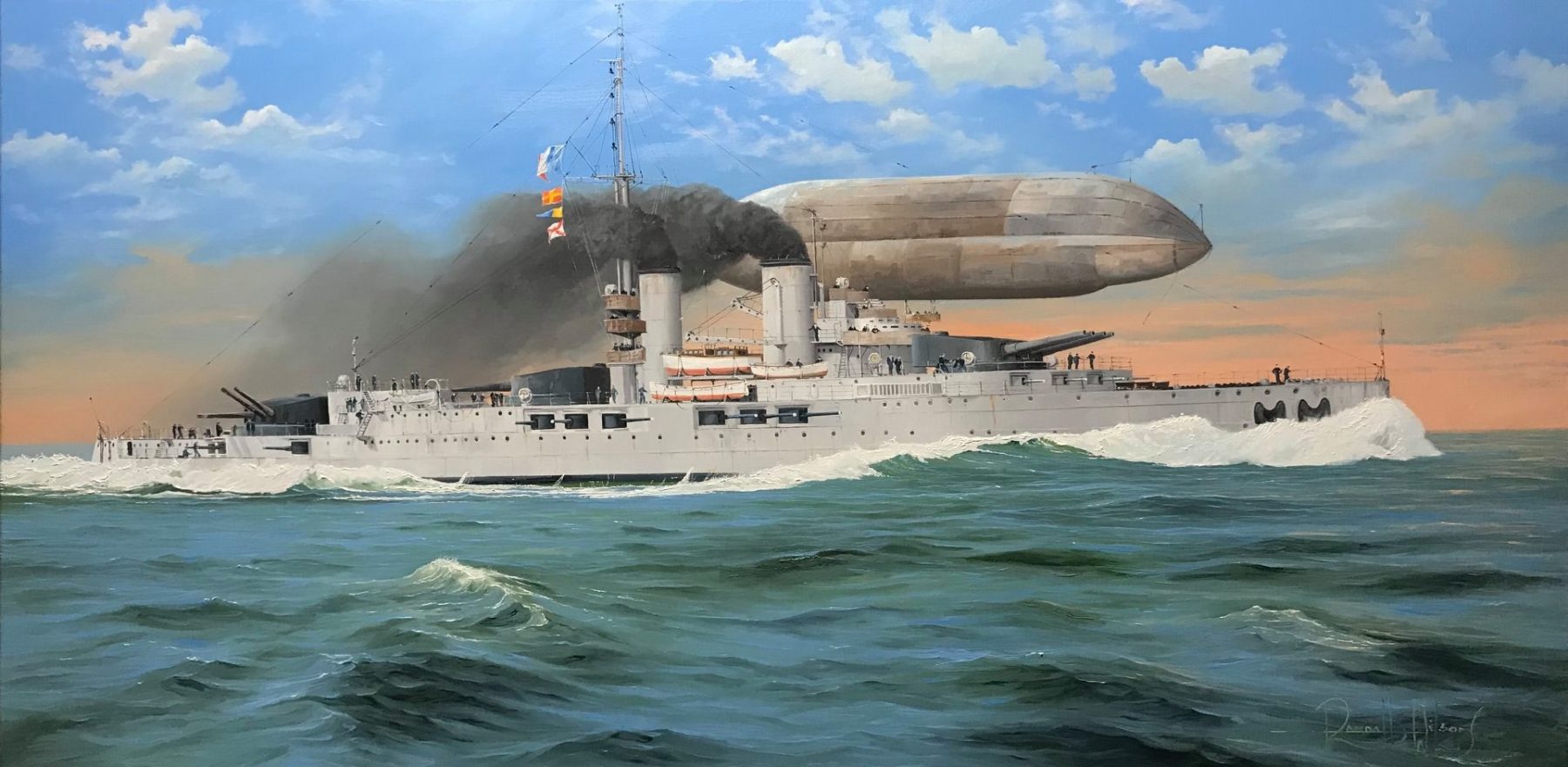
Splendid painting of the Normandie by Randall Wilson (Navart) Src
Armour-wise, the ships improved on protection, but their main belt was inferior to their caliber, 300 mm (12 in). This 11-1/2 inches armoured belt was comprised between the fore and aft barbette. The forward barbette for exmple was much father from the prow compared to the Courbet, same for the aft one, saving on armour beyond. It was indeed down to 180 mm (7-1/2 in) and 120 mm at the ends (4-3/4 in). The upper belt was 240 mm thick (9-1/2 in) amidship, then 160 mm (6-1/2) at the ends. The upper armoured deck which connected to it, was 50 mm (2 in), as the lower one with 70 mm slopes (2-1/2 in). The barbettes were 284 mm thick (11 -1/2 in) and the turrets had 340 (13.4 in) faces and 250 mm sides (9-7/8 in). Casemates were protected by 180 to 160 mm (7-6 in) and the forward conning tower had 300 mm walls (12 in). So thicker barbettes but weaker CT than on the Bretagne. Note: The Normandie class will be the object of a dedicated post.
Specs:
Displacement: 25,230 t. 27,000 t. FL estimated
Dimensions: 175,6 x 27 x 8.65 m
Propulsion: 4 shafts, 2 turbines, 2 VTE, 24 boilers, 32,000 shp, 21 knots.
Armor: 300 mm belt, 340 mm turrets, 300 mm CT, 50 mm decks, see notes.
Armament: 12 x 340mm (3×4), 24 x 138mm, 6 x 47mm, 6 x 457mm TT sub
Crew: 1200
Intermediate plans for new battleships
These unfortunate battleships were caught by the war and as work stalled completely, they were cannibalized of their powerplants, boilers and armament (the Bretagne class at the end of the war were upgraded with the Normandie”s main guns), and ultimately cancelled in 1918. However, even before, wild discussion went on in the admiralty in order to know if they were to be completed or not, adn/or upgraded taking WW1 lessons in account:
-Was considered first a top speed of 24 to 25 knots was necessary, which would have required 80,000 shp.
-Using four turbines of a brand new model.
-Improved ASW protection by fitting them with bulges one meter large at the greatest beam.
-New main gun mounts to bring the range to 26,000 m
-Better accuracy with a new fire control system fitted on top of a new tripod mast.
-Improved internal hosrizontal protection
-550 mm instead of 450 mm torpedo tubes
Discussions also went on about the completion of the Béarn, even an option for 400 mm main guns (16 in) with greater elevation in modified quad turrets. As we know, Béarn wa ultimately completed as an aircraft carrier after the signature of the Washington treaty.
Lyon class (1917)
Lyon, Duquesne, Tourville, Lille
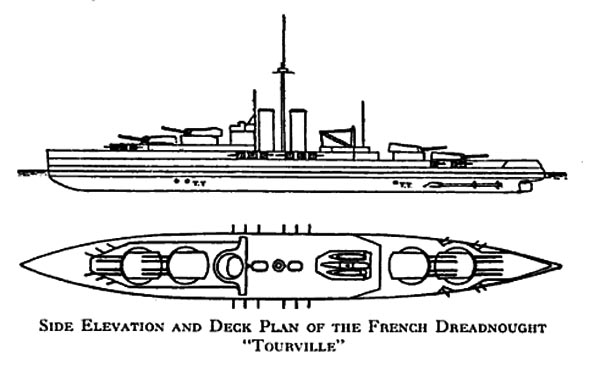
The 1912 naval law was amended when calling for four new battleships to be ordered in 1915. Design work started in mid-1913, and since longer graving docks would soon be completed in Brest and Toulon, the new ships would not be limited by infrastructure. The naval command considered increasing the caliber to 380 mm (15 in) to keep pace with the latest British battleships of the Queen Elizabeth class, but the French did not yet have a gun of that caliber completed, and the delays necessary to design and test it were deemed unacceptable. Additionally, the French expected to be fighting at ranges where the existing 340 mm gun was able to defeat heavy armor, so there was little need to step up to the larger caliber.
The 340 mm gun was adopted, but to improve the ship’s firepower, a fourth quadruple turret was added. The ships were allocated to shipyards in late 1913, with work to begin on the first two in January 1915, with the second pair to follow at an unspecified time. Work to complete the design continued into 1914, but the details of the ships’ underwater protection system had not yet been finalized by the time war broke out in August 1914. With the start of the war, the project was cancelled; no work was done and no material was assembled for the vessels. They would stay at paper stage only. But if completed and modernized in the interwar, they would have been quite formidable opponent for any navy. The quad turret design went on with the new Dunkerque and Richelieu class, but intermediate projects based on allocated Washington treaty called for triple and twin turrets. Fortunately we have more info about these. To this this interwar desing process, read the Dunkerque genesis. Note: This class will be the object of a standalone post in the future.
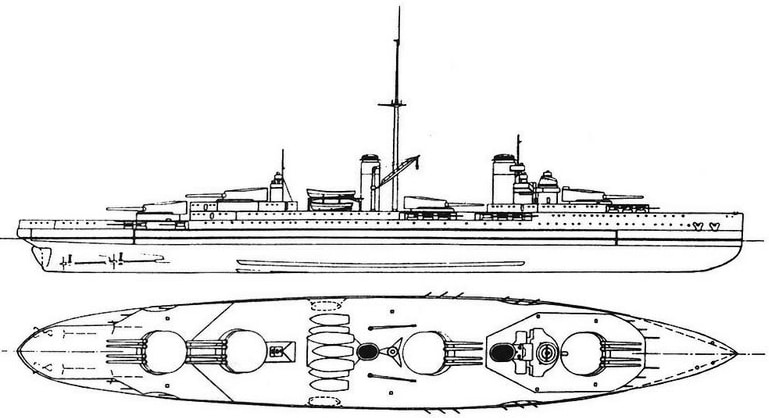
Specs:
Displacement: 29,000 t. 32,000 t. FL estimated
Dimensions: 194,5 x 29 x 9.2 m
Propulsion: 4 shafts turbines, 32 boilers, 43,000 shp, 23 knots.
Armor: see notes.
Armament: 16 x 340mm (4×4), 24 x 138mm, ? 40-47mm, 6 TT sub
Crew: circa 1400
French Battlecruiser projects (1912-14)
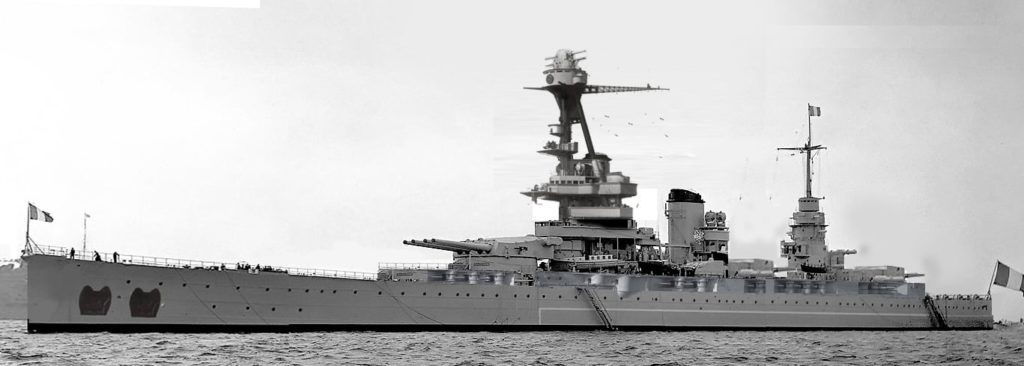
A what-if author’s impression of the Durant-Viel second project, if built and modernized in the interwar
Gille’s battlecruisers:
Ministry of Marine (under De Lapeyrière) requirements was of for a 28,000 tonnes, 27 knots, eight 340 mm guns armed ship. This led to three designs, one by Gille submitted in 1913 and two by Furant-Viel in 1913: Gille’s design named “cuirassé-croiseur” (‘battleship-cruiser’) was apparently intended more as a fast battleship but with a lighter armor: 270 mm for the main belt (10 in). Preliminary designs in 1912 showed the eight main battery guns in three quadruple turrets like the Normandie class design, saving turet weight and concentrating armour better. These 13.4 in, 15 calibers model 1912 could fire 2 rounds per minute but the arrangement was more risky if one turret was hit and also in shells dispersion.
Durant-Viel’s battlecruisers:
Design “A” was based on 27,500 t, 210m long, 27m in beam. They needed to reach 27 knots, and were equipped with direct-drive turbines for 74,000 shp fed by 22 mixed boilers. Range should have been 3500 nm, or six hours of full speed steaming ahead. Armamnt wad the same, eight 340mm/45 M1912 in quad turrets. Compared to Gilles design, they only had two turrets fore and aft. The Secondary armament was the same 138.6 mm casemated. The forward turret was mounted on the forward casemate superstructure. The entire protection was the same as Normandie in layout, but thinner. The belt still was 280 mm thick, much better than British WW1 battleships (229 mm for hms Lion). They were closer to German battlecruisers and slower. Again, the same critics were valid for their quad turrets.
Gille’s design armour layout (1913)
Read More/Src
French Battleships 1914–45 New Vanguard 266, Ryan K. Noppen
https://en.wikipedia.org/wiki/French_battlecruiser_proposals
https://weaponsandwarfare.com/2019/12/22/french-prepost-dreadnoughts/
Dumas, Robert (1985). “The French Dreadnoughts: The 23,500 ton Courbet Class”. John Roberts (ed.). Warship. IX.
Dumas, Robert & Guiglini, Jean (1980). Les cuirassés français de 23,500 tonnes. 4 Seigneurs Eds.
Friedman, Norman (2011). Naval Weapons of World War One: Guns, Torpedoes, Mines and ASW Weapons of All Nations; Seaforth Publishing.
Gardiner, Robert & Gray, Randal, eds. (1985). Conway’s All the World’s Fighting Ships 1906–1921.
Gardiner, Robert & Gray, Randal, eds. (1985). Conway’s All the World’s Fighting Ships 1860–1905.
Gille, Eric (1999). Cent ans de cuirassés français, Nantes: Marines édition.
Halpern, Paul G. (2004). The Battle of the Otranto Straits: Controlling the Gateway to the Adriatic in World War I. Indiana University Press.
Jordan, John & Caresse, Philippe (2017). French Battleships of World War One. Naval Institute Press.
Jordan, John & Dumas, Robert (2009). French Battleships 1922–1956. Naval Institute Press.
Whitley, M. J. (1998). Battleships of World War Two: An International Encyclopedia. Naval Institute Press.

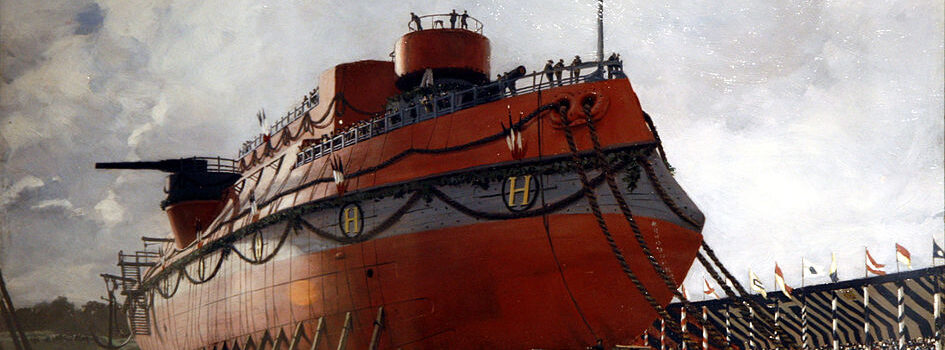

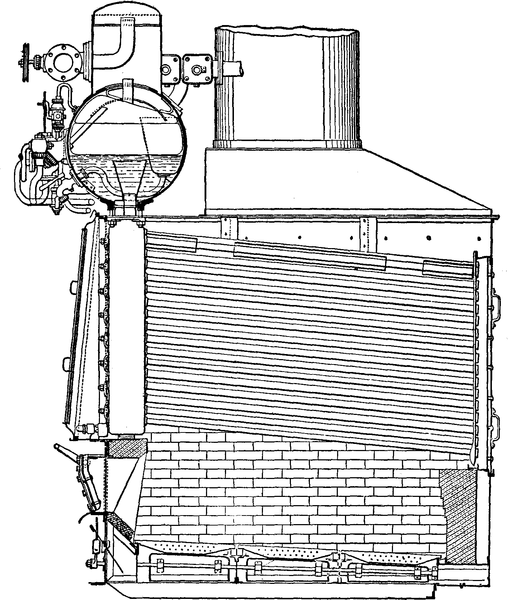
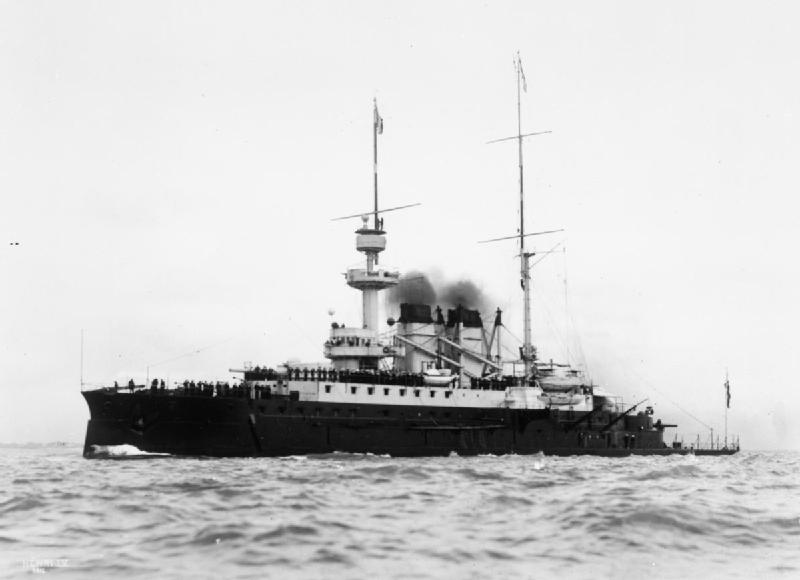
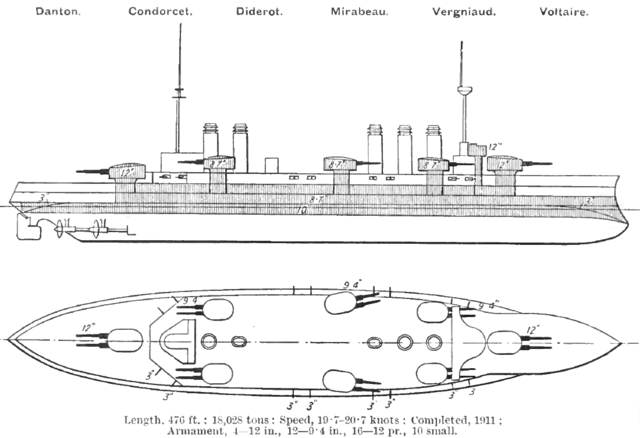
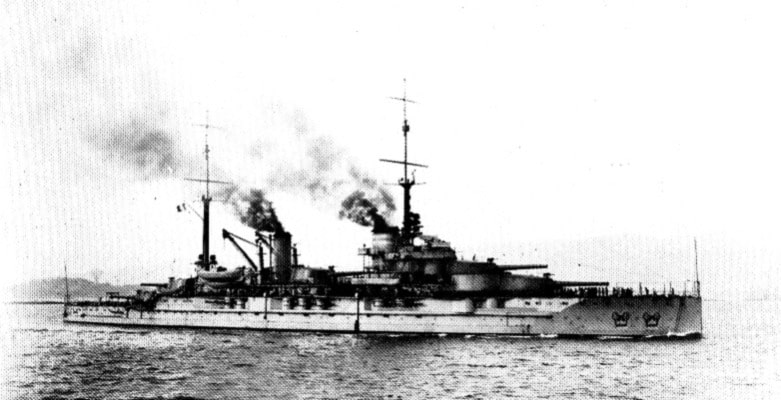
 Latest Facebook Entry -
Latest Facebook Entry -  X(Tweeter) Naval Encyclopedia's deck archive
X(Tweeter) Naval Encyclopedia's deck archive Instagram (@navalencyc)
Instagram (@navalencyc)





 French Navy
French Navy Royal Navy
Royal Navy Russian Navy
Russian Navy Armada Espanola
Armada Espanola Austrian Navy
Austrian Navy K.u.K. Kriegsmarine
K.u.K. Kriegsmarine Dansk Marine
Dansk Marine Nautiko Hellenon
Nautiko Hellenon Koninklije Marine 1870
Koninklije Marine 1870 Marinha do Brasil
Marinha do Brasil Osmanlı Donanması
Osmanlı Donanması Marina Do Peru
Marina Do Peru Marinha do Portugal
Marinha do Portugal Regia Marina 1870
Regia Marina 1870 Nihhon Kaigun 1870
Nihhon Kaigun 1870 Preußische Marine 1870
Preußische Marine 1870 Russkiy Flot 1870
Russkiy Flot 1870 Svenska marinen
Svenska marinen Søværnet
Søværnet Union Navy
Union Navy Confederate Navy
Confederate Navy Armada de Argentina
Armada de Argentina Imperial Chinese Navy
Imperial Chinese Navy Marinha do Portugal
Marinha do Portugal Mexico
Mexico Kaiserliche Marine
Kaiserliche Marine 1898 US Navy
1898 US Navy Sovietskiy Flot
Sovietskiy Flot Royal Canadian Navy
Royal Canadian Navy Royal Australian Navy
Royal Australian Navy RNZN Fleet
RNZN Fleet Chinese Navy 1937
Chinese Navy 1937 Kriegsmarine
Kriegsmarine Chilean Navy
Chilean Navy Danish Navy
Danish Navy Finnish Navy
Finnish Navy Hellenic Navy
Hellenic Navy Polish Navy
Polish Navy Romanian Navy
Romanian Navy Turkish Navy
Turkish Navy Royal Yugoslav Navy
Royal Yugoslav Navy Royal Thai Navy
Royal Thai Navy Minor Navies
Minor Navies Albania
Albania Austria
Austria Belgium
Belgium Columbia
Columbia Costa Rica
Costa Rica Cuba
Cuba Czechoslovakia
Czechoslovakia Dominican Republic
Dominican Republic Haiti
Haiti Hungary
Hungary Honduras
Honduras Estonia
Estonia Iceland
Iceland Eire
Eire Equador
Equador Iran
Iran Iraq
Iraq Latvia
Latvia Liberia
Liberia Lithuania
Lithuania Mandchukuo
Mandchukuo Morocco
Morocco Nicaragua
Nicaragua Persia
Persia San Salvador
San Salvador Sarawak
Sarawak Uruguay
Uruguay Venezuela
Venezuela Zanzibar
Zanzibar Warsaw Pact Navies
Warsaw Pact Navies Bulgaria
Bulgaria Hungary
Hungary

 Bundesmarine
Bundesmarine Dutch Navy
Dutch Navy Hellenic Navy
Hellenic Navy Marina Militare
Marina Militare Yugoslav Navy
Yugoslav Navy Chinese Navy
Chinese Navy Indian Navy
Indian Navy Indonesian Navy
Indonesian Navy JMSDF
JMSDF North Korean Navy
North Korean Navy Pakistani Navy
Pakistani Navy Philippines Navy
Philippines Navy ROKN
ROKN Rep. of Singapore Navy
Rep. of Singapore Navy Taiwanese Navy
Taiwanese Navy IDF Navy
IDF Navy Saudi Navy
Saudi Navy Royal New Zealand Navy
Royal New Zealand Navy Egyptian Navy
Egyptian Navy South African Navy
South African Navy






























 Ukrainian Navy
Ukrainian Navy dbodesign
dbodesign